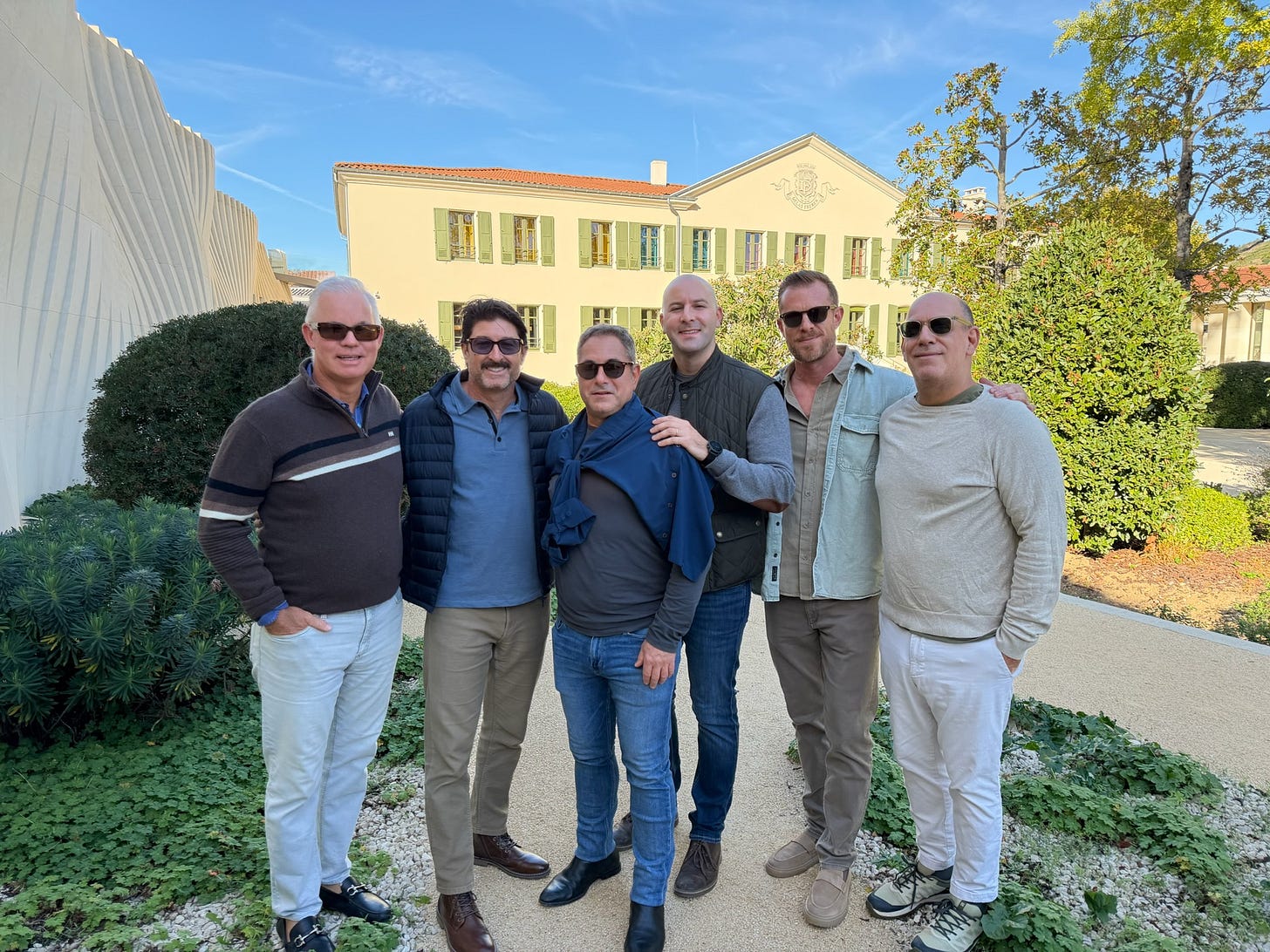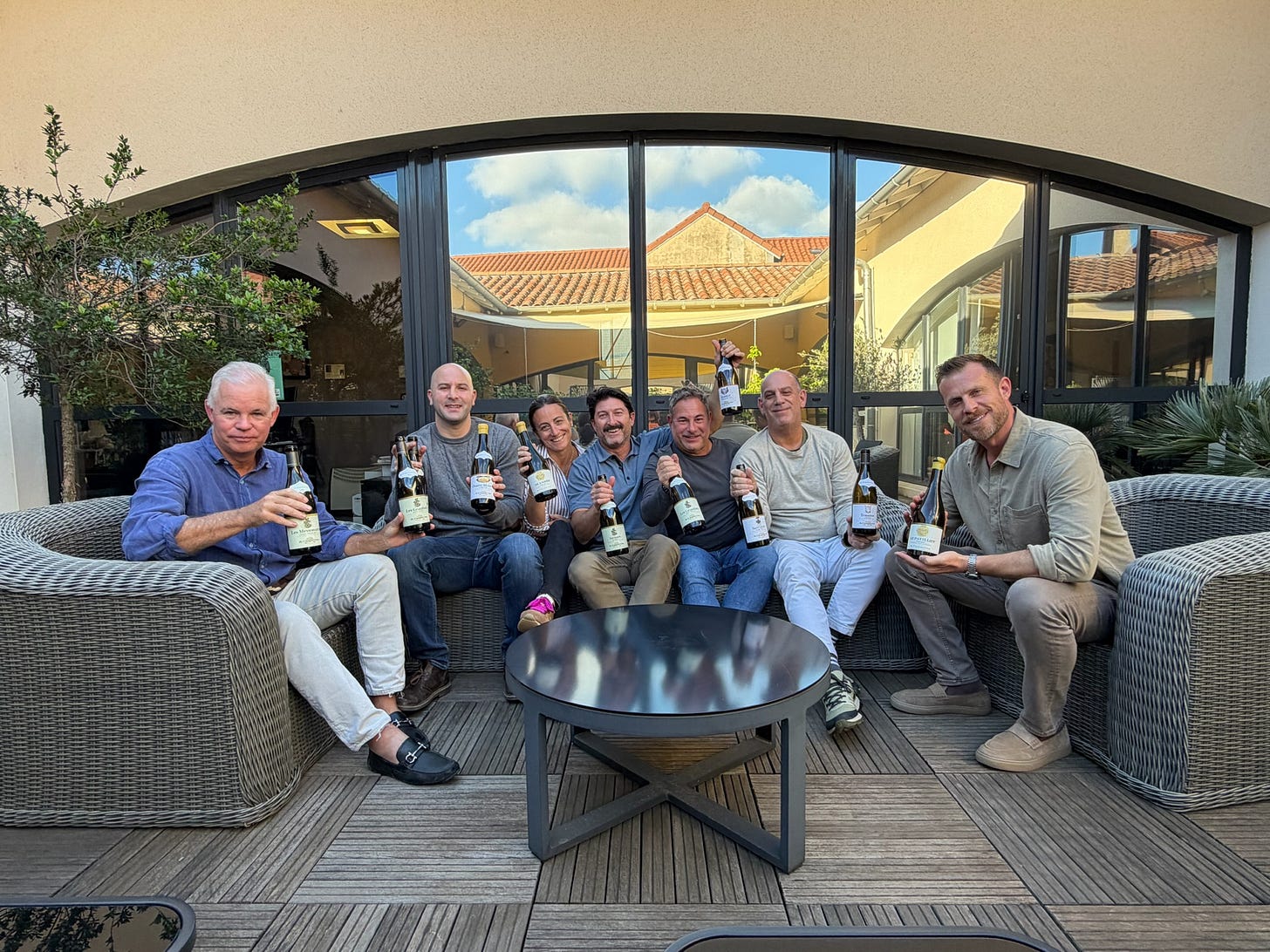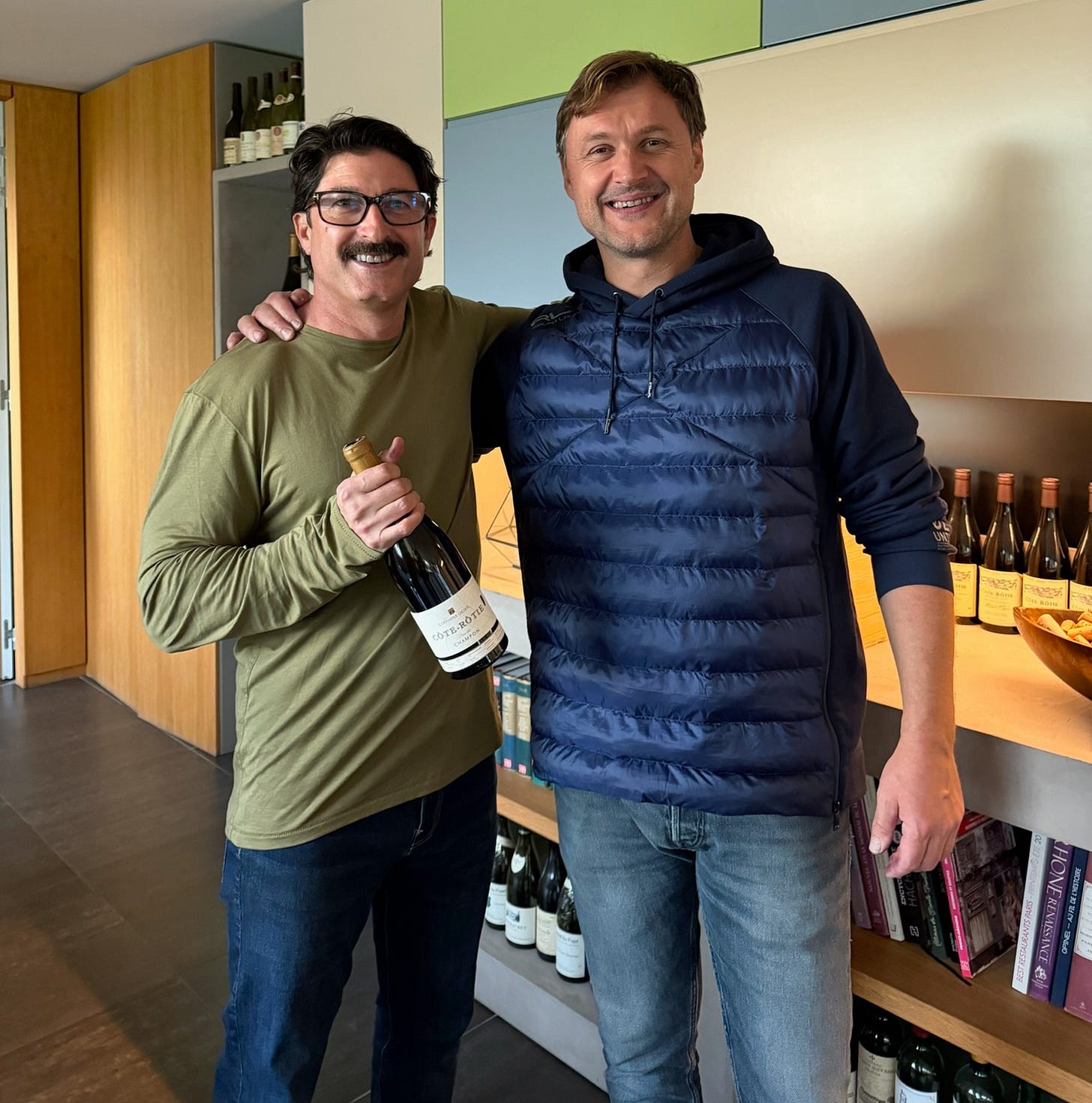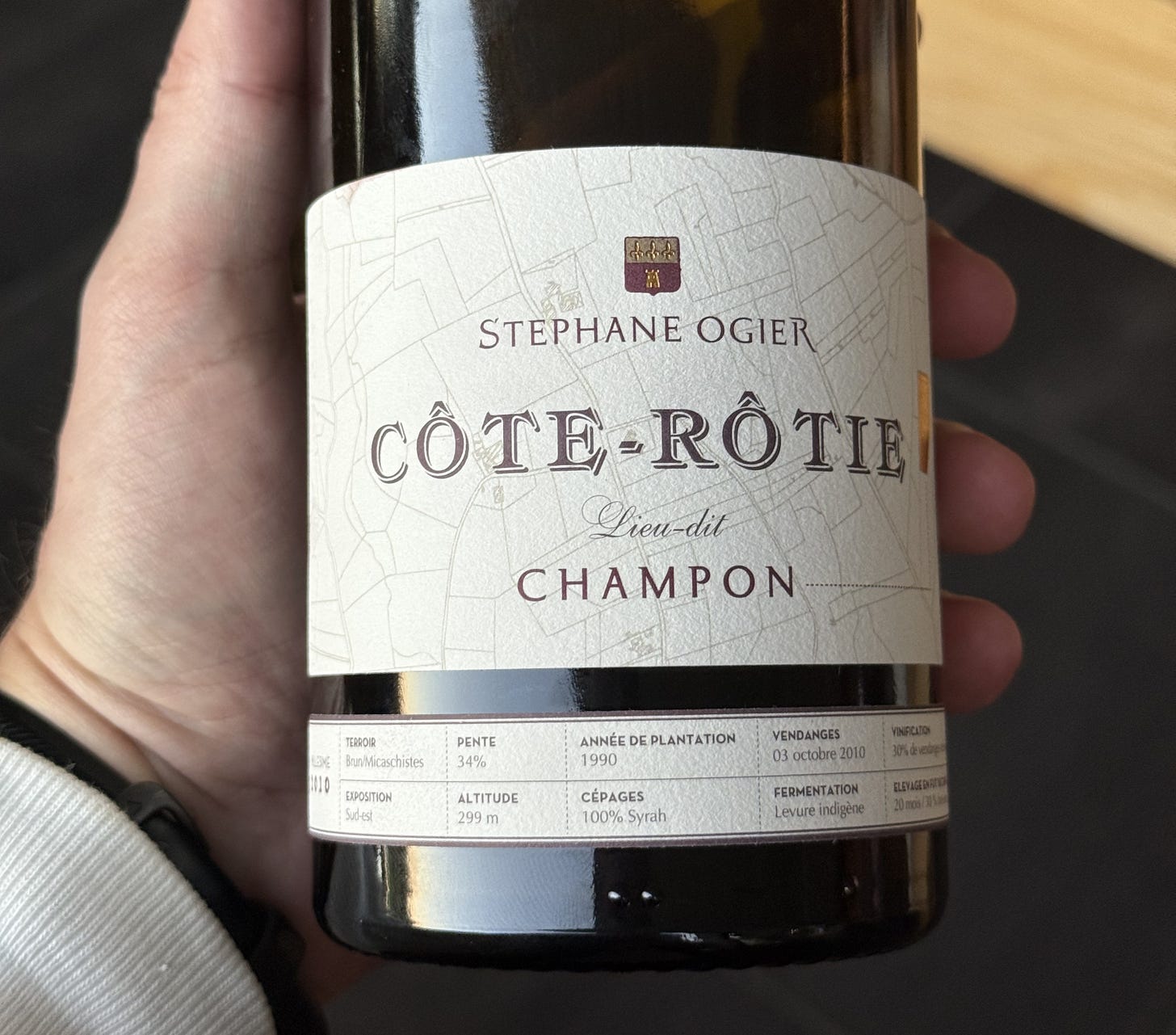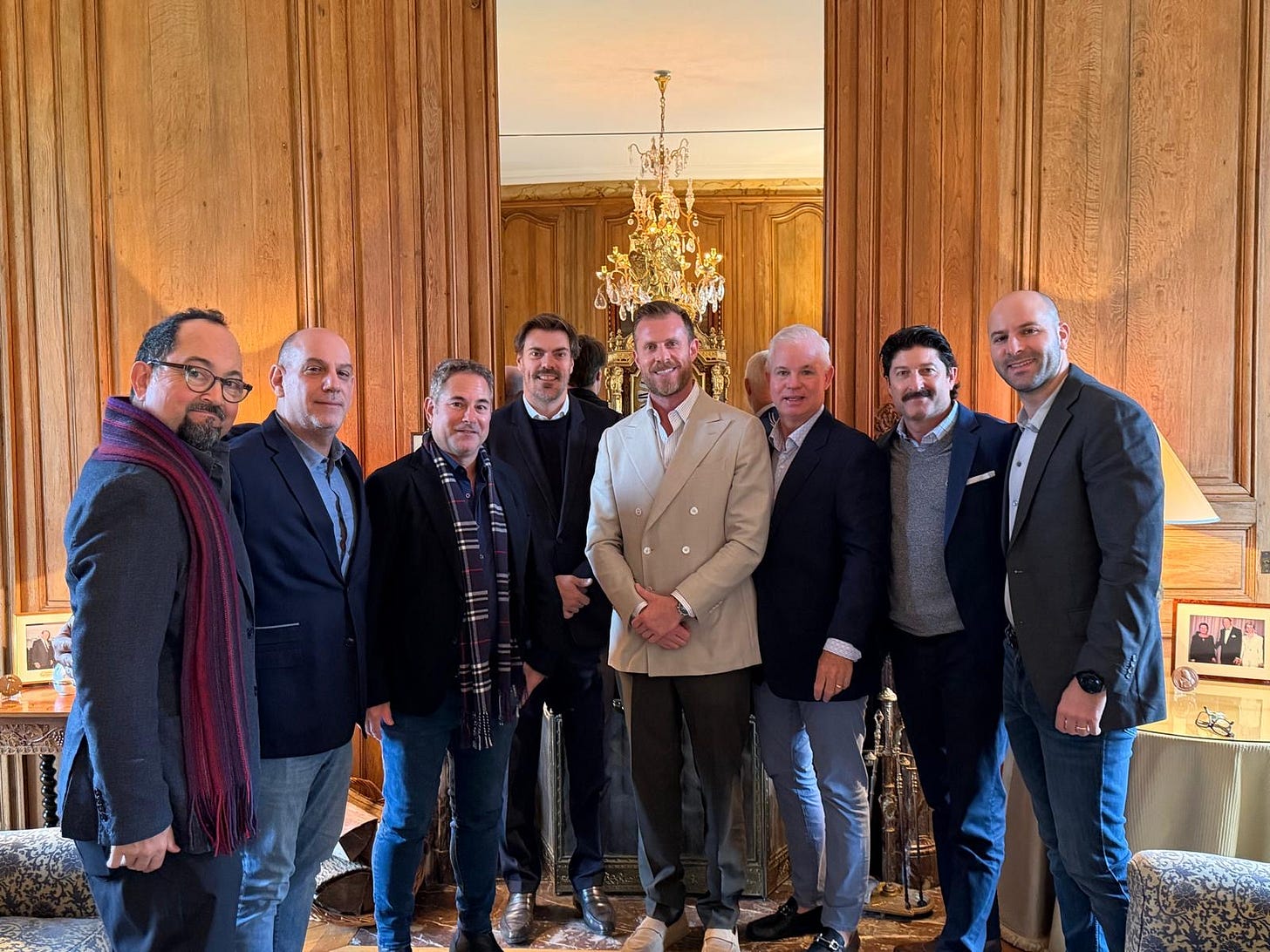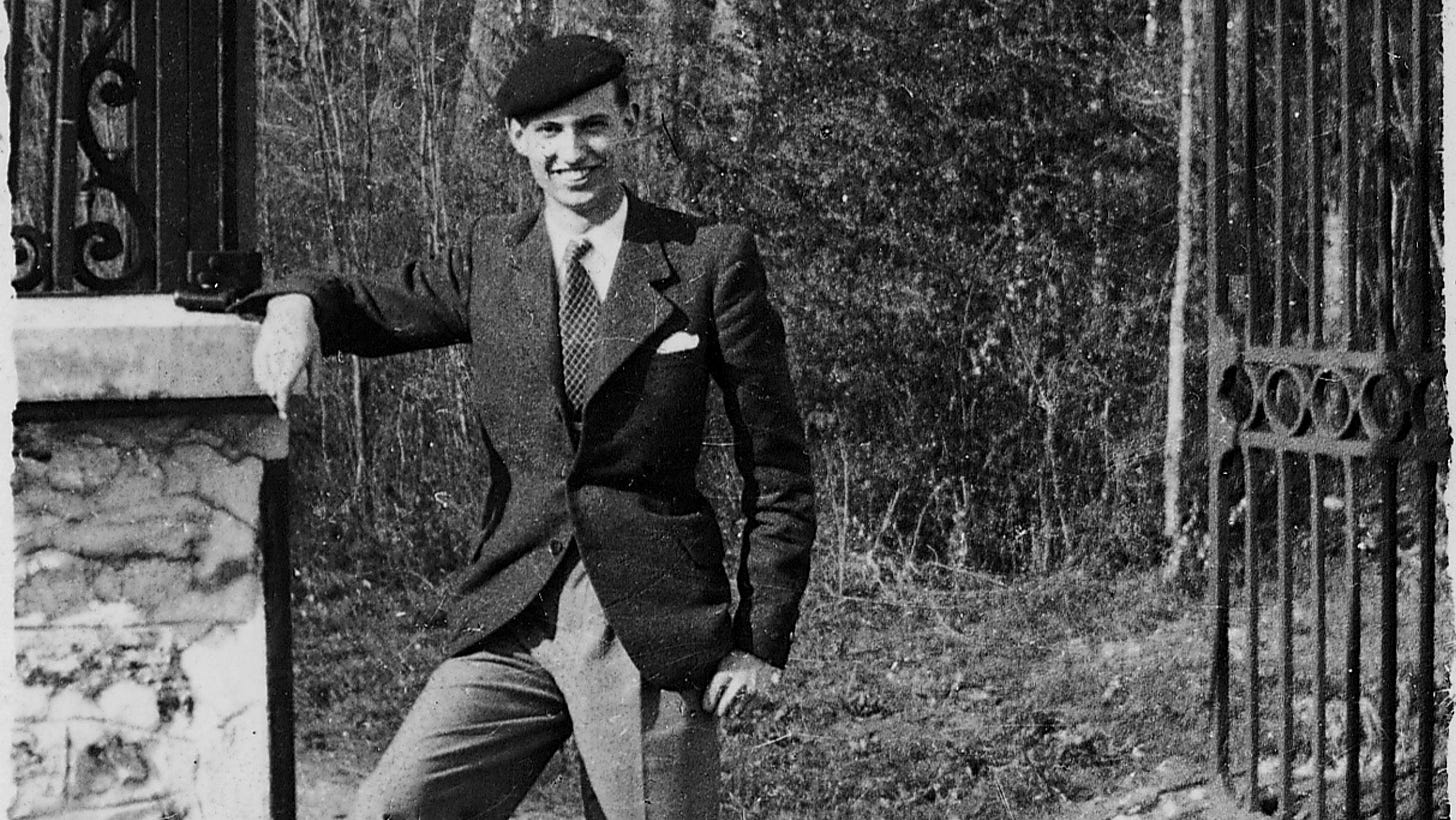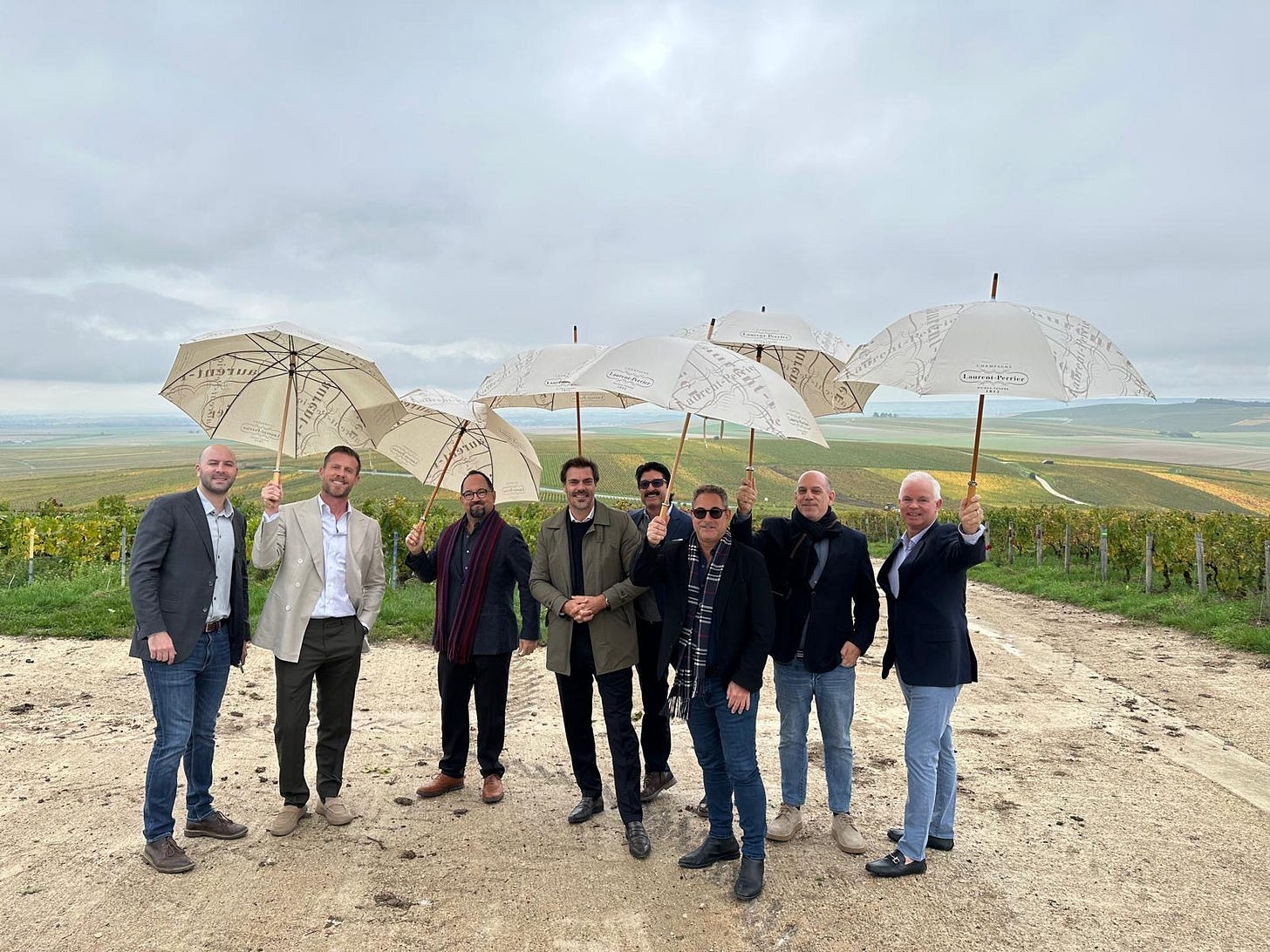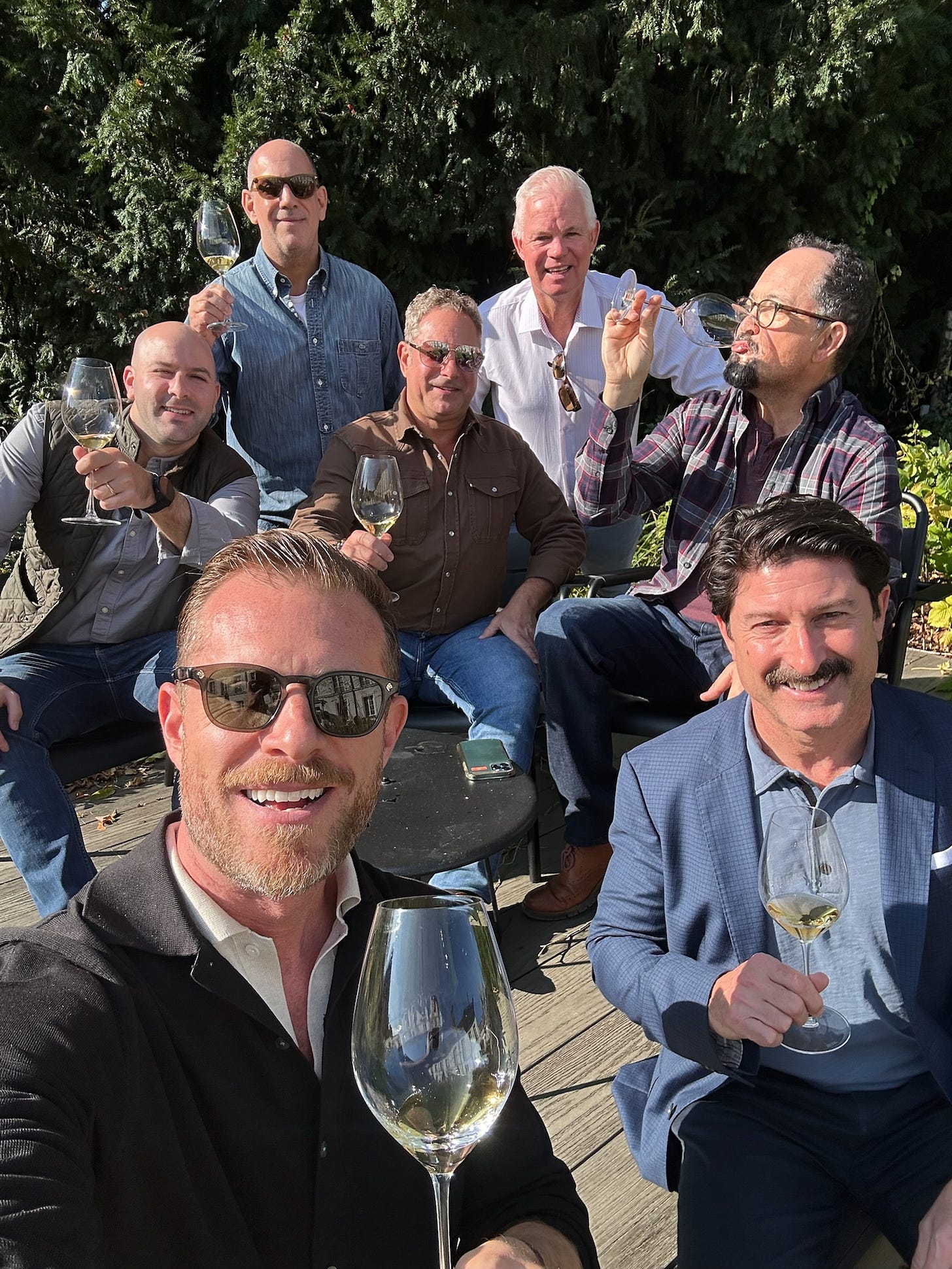Wine Club Miami Goes to France
The one week rodeo through the Northern Rhône and Champagne came to define our club. Here's how.
“There’s always strikes in France,” I said to my friend in Paris after my opera tickets got canceled.
“We invented the strike,” he responded with a smile.
A week later, our club would learn that strikes, with a touch of violence, would make Champagne what it is today. “In 1911, there was a revolution in Champagne,” Bereche et Fils winemaker Raphael Bereche said as our club walked his family’s cellar in Ludes, just south of Reims. “Five hundred growers from Aÿ broke into the big Champagne houses and broke everything.”
No chopped off heads at least. We think. But why did growers get pissed? This was during the height of Phylloxera in France, where a microscopic pest decimated vineyard yields and rendered vines useless. Houses went to other places in France such as the Loire Valley to source grapes for sparkling wine. Growers didn’t have it. CHAMPAGNE COMES FROM CHAMPAGNE.
And today, it is the strongest name in wine. People say the two most recognizable names on earth are Jesus and Michael Jordan. Champagne is third. Period.
This is one of many things we would learn on our 20th anniversary trip to France, where we celebrated an important anniversary for our club, started in 2005 by our current president Jeff Tenen. We started on October 5th in the Rhône Valley, and finished in Champagne on October 12th. The following is our best attempt at a recap of our visits and the hospitable people and generous wineries that made it possible:
As we arrived in tranches to the Tain L’Hermitage train station, we made our way across the wooden planks of the iconic Passerelle Marc Seguin pedestrian bridge to Tournon-sur-Rhône, the small town that mirrors Tain L’Hermitage and the beautiful, sun drenched Hermitage hill behind it. Our hotel, Hôtel de la Villeon, is wedged into a mountain with a near vertical slope of terraced vines. This is the famous St. Joseph appellation we would later learn. Also, Bordeaux isn’t the only place with ‘right and left banks’. Here in Hermitage, St. Joseph is ‘right bank’ and Hermitage is ‘left bank’, based on the flow of the river winding south.
Sunday was a travel/rest day. Everyone got in on different flights (Matt and Stephen had an incredible experience with Air France which I recommend you ask them about), and we had a long week to prep for. Being in a small town, nothing is open on Sunday night, or Monday for that matter. But we landed a reservation at Le Quai right across the bridge. We ordered the prix-fixe menu (something we’d be doing a lot of!) and started the trip with a Y. Cuilleron Saint Joseph Cavanos 2015 and the Domaine des Grands Chemins Crozes Hermitage 2022. The aromas on the St. Joseph were powered by a smooth brick wall of black fruit and poultry. A solid start and early nightcap after a long day making it to wine country. Our spirits were so high.
Day One - October 6
The good thing about being in Hermitage is how close we were to our first two stops: Maison Delas Frères and M. Chapoutier. We left the hotel at 9:50am for our 10am appointment at Delas. Our jaws dropped when we walked in to greet Bruno Gallet, our amazing host for the day. The winery is an architectural masterpiece. If you hate wine but love design, still go and make the pilgrimage. Just drink the pure, saline sparkling water at least.
Founded in 1835, Delas has a strong history in the region, but it’s only in the last 30 years that its wines have gotten global recognition. Delas was bought by Champagne Louis Roederer in 1993, and recently went through a $23 million renovation that was completed in 2019. Designed by Swedish-born but Paris-based architect Carl Fredrik Svenstedt, the winery is its own world with an open air section in the middle, dotted with wavy patches of plants, rocks, and large trees. The rest is gravel pathways that leads to the winery, originally restored house and cellars, and a welcome center. The only thing that seeps in from the town is the silence and wind, the rest, including its inner peace, is a product of the energy this place emits.
The most impressive part of the winery is the standalone wall: a giant wave of limestone that is beautiful to look at but impossible to comprehend. The undulating wall is 283 feet long and 23 feet high, with a geometrically stable, structural form. The wall is made from limestone blocks individually carved by robots which are post-tensioned to the foundations and bonded horizontally using stainless steel cables. A work of art.
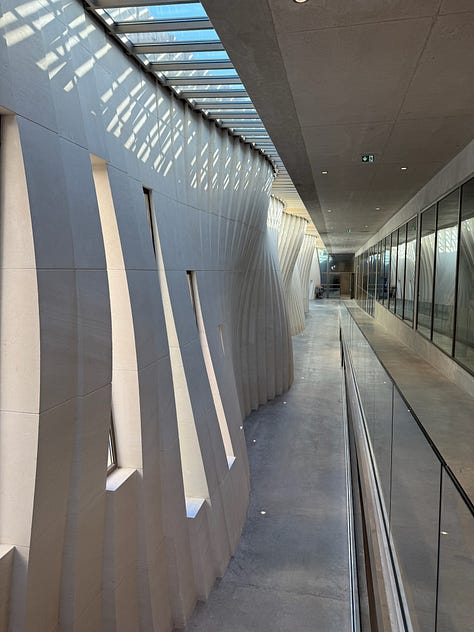
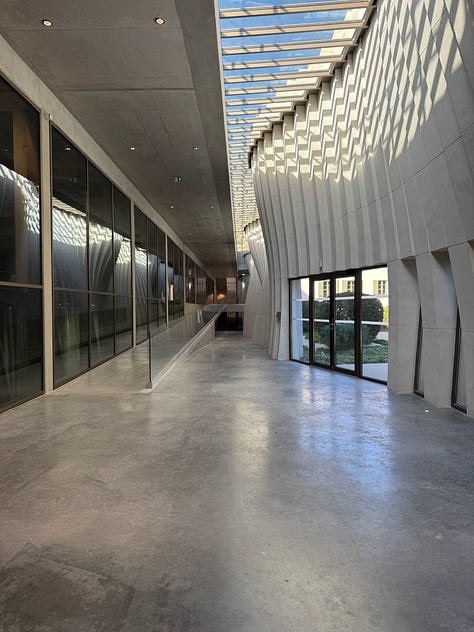
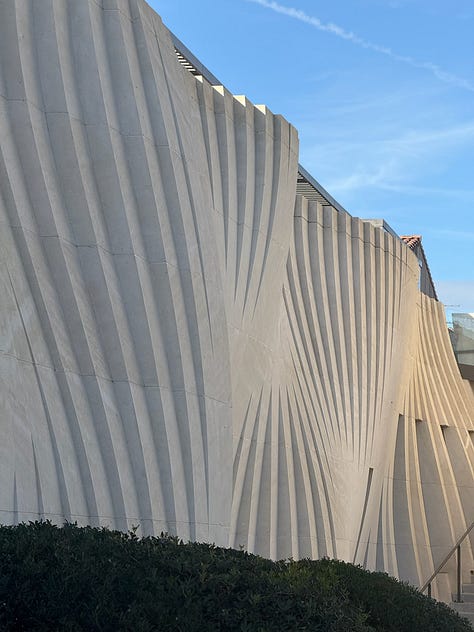
We arrived just as harvest ended, which was a good thing. The winery was empty and all the fruit was busy fermenting, not minding our presence. We put on neon ‘visitor’ vests and explored the stainless steel tanks and French oak barrels, looking like a group of city inspectors. Bruno explained how Delas’ winemaking process mostly blends stainless steel and barrel fermented wines together into one, aside from the top Hermitage bottlings. After the brief winery tour, we took off the vests and headed over to the welcome house, where the winery hosts private events, guests, and critics. The staircase is like a giant wooden ribbon that spins down all the floors, from the top floor to the underground cellar, a close second design marvel behind the Delas wall. The underground cellar is a straight hallway that runs the span of the house, with rectangular concrete cubbies that house the estate’s important bottles like the 1990 Les Bessards Hermitage, the first single vineyard wine from Delas. Unfortunately, there’s not a lot of old bottles there.
Enough about design and cubbies filled with wine. We got tasting to do. The wines were already prepped by Bruno and our other host Celia Goudard. In order, we tasted:
Delas Frères Condrieu Clos Boucher 2023, an aromatic white wine typical of Viogniers but very balanced with lots of surprising freshness. It has a midpalate creaminess to it, and could pair with scallop, lobster, and could even tackle the toughest pairing of all: asparagus. It comes from 40 year old vines!
Delas Frères Saint Esprit Cote du Rhone 2023, a Syrah + Grenache blend that is primary fruit driven and pleasing. A whopping 600,000 bottle production behind this.
Delas Frères Domaine des Grands Chemins Crozes Hermitage 2022. Now we are talking. Meat, olive, dark fruit, roasted black cherry, poultry, this is the entry to Hermitage flavors, but very beginner. Grapes are sourced from flat land, machine harvested, and alluvial soils.
Delas Frères Francois de Tournon Saint Joseph 2022. This wine showed good spice, power, rich red fruit, lots of loaded strawberry. We see a different profile here from the steep slope, and granite, poor soils too. This is aged and fermented 60% stainless steel and 40% new oak, showing the Delas way.
Delas Frères Chante Perdrix Cornas 2022. The Cornas has solid concentration that captures the sun’s energy in this solar area. For those who love bolder wines, this is a good beginner Cornas that’ll hook you into Rhone’s hottest sub-appellation.
Delas Frères Seigneur de Maugiron Côte Rôtie 2022. Delas isn’t known for its Cote Rotie, but this is a good effort with a 100% Syrah from the steepest slopes of the Rhone. The wine has great lift, violet dry roses, more flowers, very sexy. It is 100% barrel fermented and aged. Sourced from schist soils on Cote Brune mostly.
Delas Frères Domaine des Tourettes Hermitage 2022. Nicknamed the ‘spirit of hermitage’, this was a favorite of the tasting. It is pure balance with nice acidity, cool herbs, mint, fine grained tannins, and just so approachable at this young age. We took some back to the states in our suitcase!
Delas Frères Les Bessards Hermitage 2020. Like 2022, 2020 was also a great vintage with lots of ripeness. The single vineyard Hermitage is sourced from 60-90 year old vines. Upon first taste, I looked at David who said, “O La La!” The profile of cigar box, strawberry, and red cherry made a mark here.
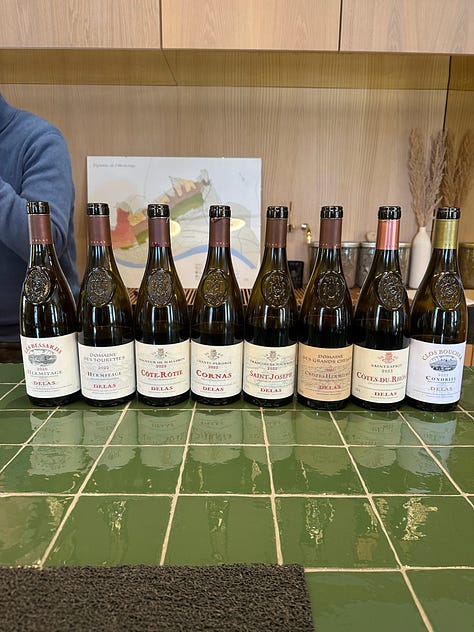
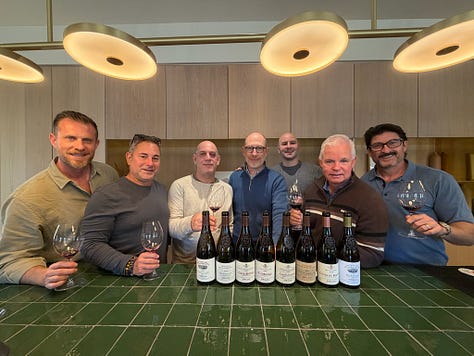
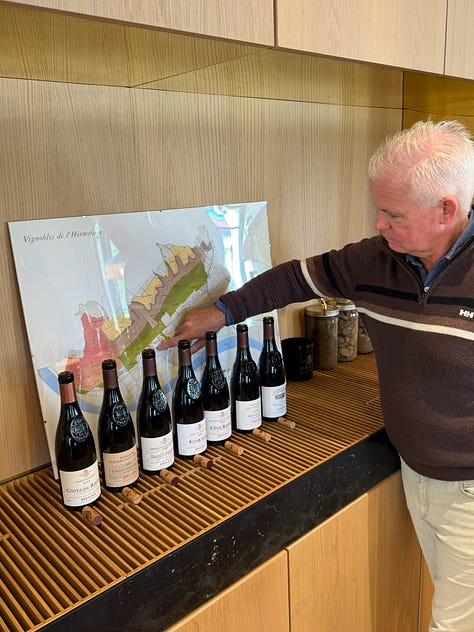
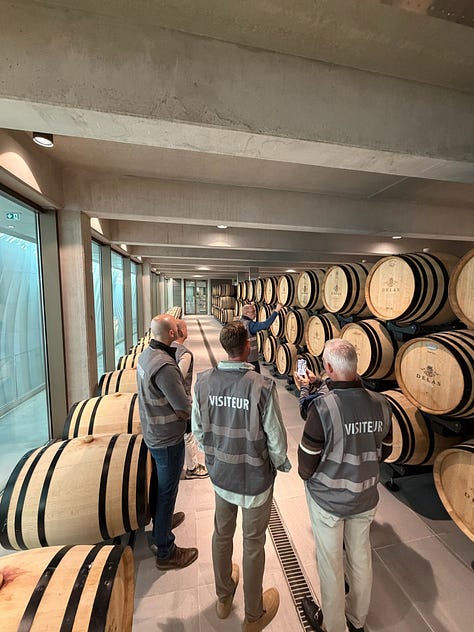
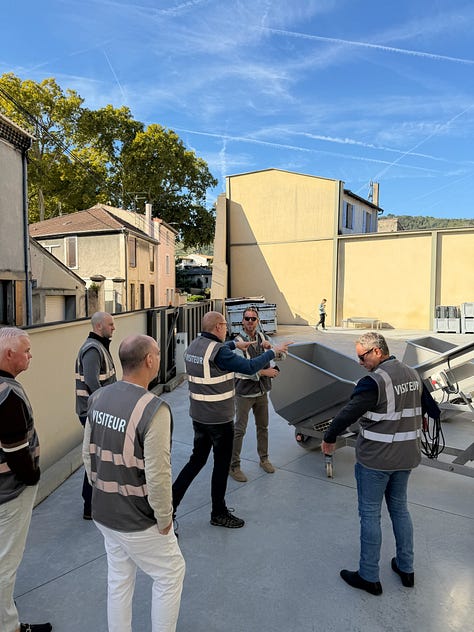
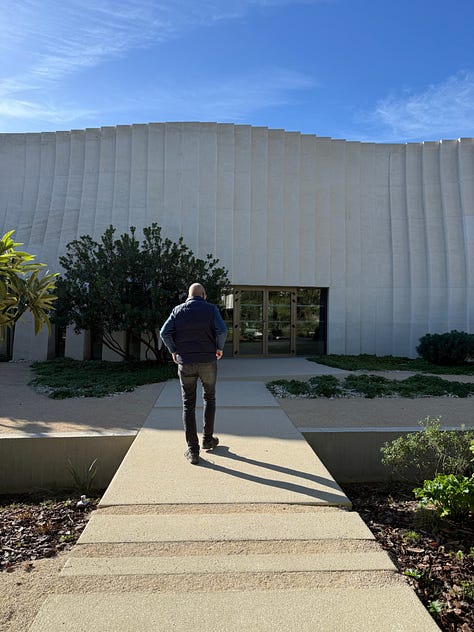
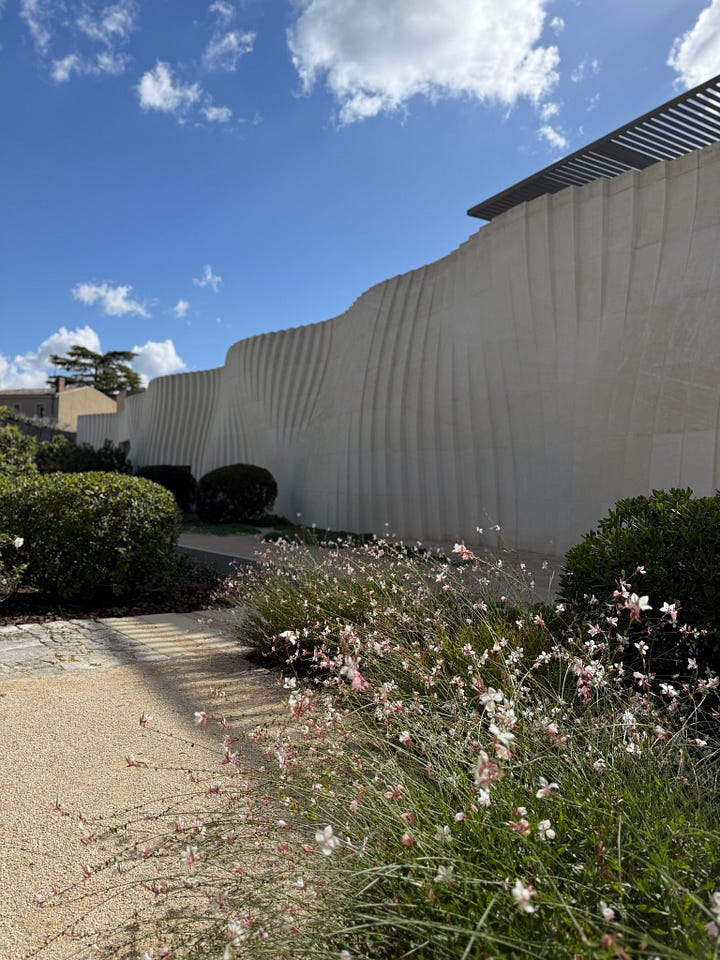
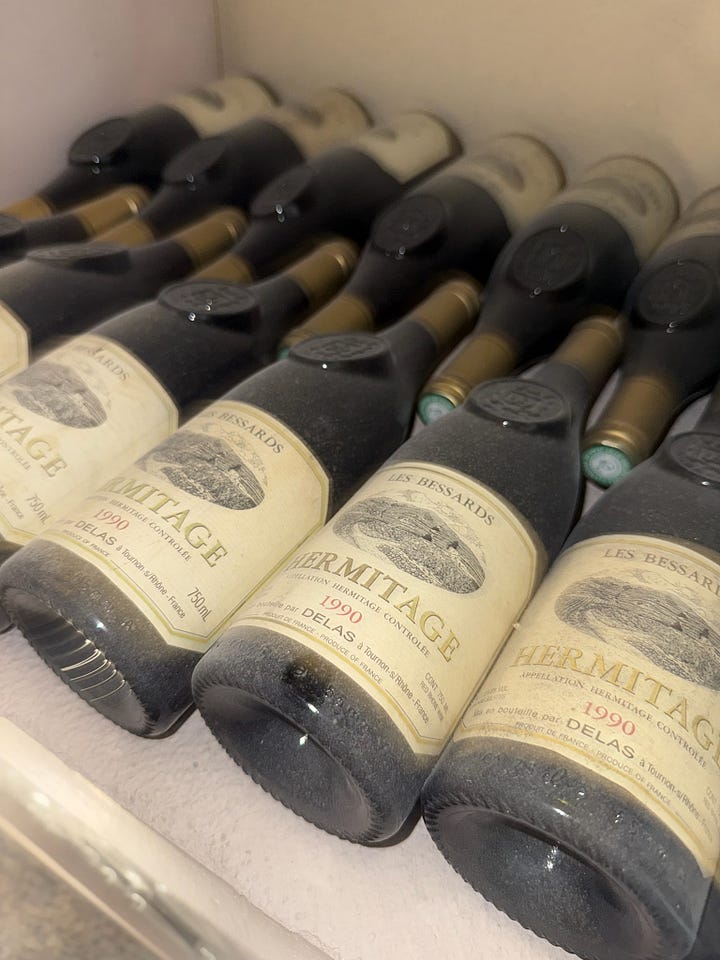
Organizing trips isn’t easy. Things fall through the cracks. But sometimes going impromptu is fun. We were supposed to have a lunch scheduled after the Delas visit but a mix up in dates had us scrambling to find a quick bite to eat in a small town on a Monday. Remember? Everything is closed. But luckily, a Shawarma place in the town square was open. The young, Uzbek owner made us platters and gyros that gave us energy to keep the engine running for M. Chapoutier. We needed Diesel fuel because Chapoutier is the big boy on Hermitage, with over one third of the hill under ownership (a big sign with the winery name pegged into the hill reminds you of that).
We were blessed with great weather for all seven days, and today was blue skies and all sun. Filled with salt, Orangina, and fries, we made our way to see Marion Tricoire, our host for the visit. We started by walking to the base of Hermitage where we looked at the famous Le Meal vineyard up close. From top to bottom, you see various soil profiles up close which shows you that Le Meal is quite diverse. In Burgundy you see the same thing, where the ‘filet mignon’ of the slope usually lies in the middle. It was incredible to see cloud shadows convert to sunlight in a sliding fashion. No other place captures the importance of sun and wine than Hermitage.
M. Chapoutier was founded in 1808 and comprises 60% red and 40% white production, both equally stunning. You don’t need Google maps to tell you when you get to Hermitage. Just look until you see the big ‘M. Chapoutier’ sign that’s been there for decades overseeing every harvest. The name personalizes the business after the several generations of owners starting with the letter ‘M’ (Marius, Marc, Michel…it’s got a ring to it).
The current proprietor, Michel, has made monumental impacts on the business, starting with plot selections in 1989 and biodynamic cultivation in 1990 (before it was cool). Every year, the winery loses 20% of its production to hail, but with so much estate fruit, so much demand, so much quality, M. Chapoutier gets to see another harvest. Michel doesn’t only have an impact on production and farming, but inclusivity too. The first label to feature Braille was the 1996 Hermitage “La Sizeranne”, named after local legend Maurice de La Sizeranne, who was himself blind. Michel wanted wine information to be accessible for all, making labels readable by touch.
After the geological vineyard lesson from Marion, we started to get our bearings more and more. The region started to make sense, with Crozes Hermitage, Hermitage, and St. Joseph around us, and Cornas a long distance away to the south. From Hermitage, you get to see how Cornas is protected from the northern winds by a giant mountain, giving the south facing slope zero breeze and loads of sun. The word Cornas comes from a Celtic term called “burned ground”, which is exemplified by these natural forces of pure sun concentration with zero respite from the breeze, leading to ultra concentrated, juice berries but still plenty of acidity from the cool temperatures at night. These are similar to some wines you find in the Salta region of northern Argentina with high altitude and close proximity to the sun.
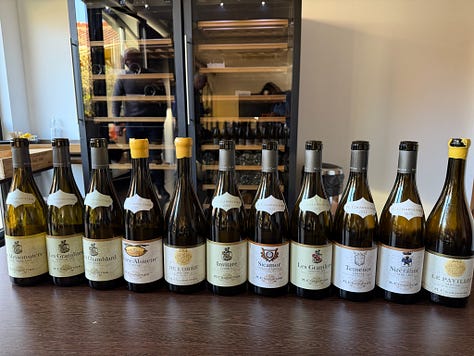
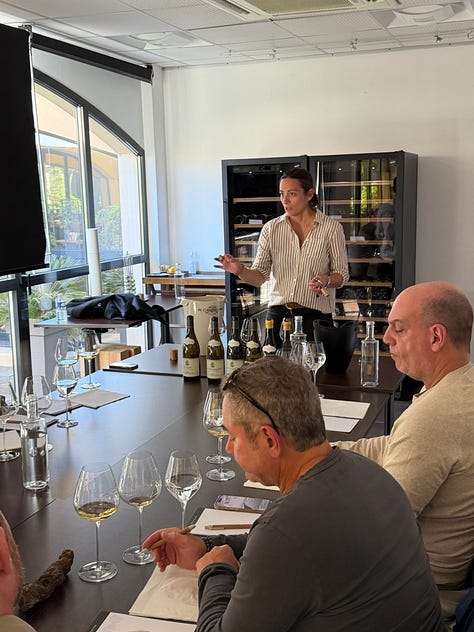
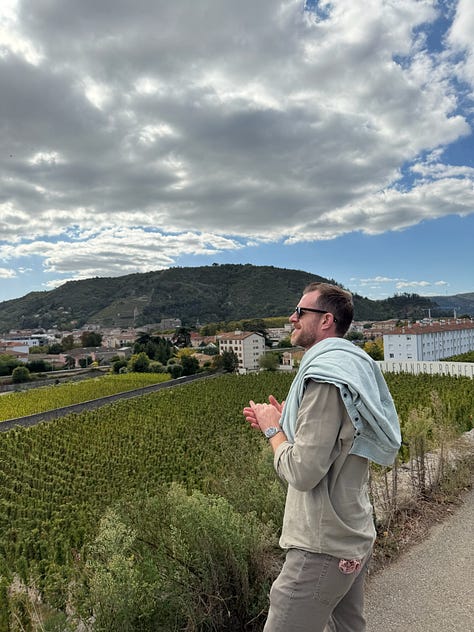
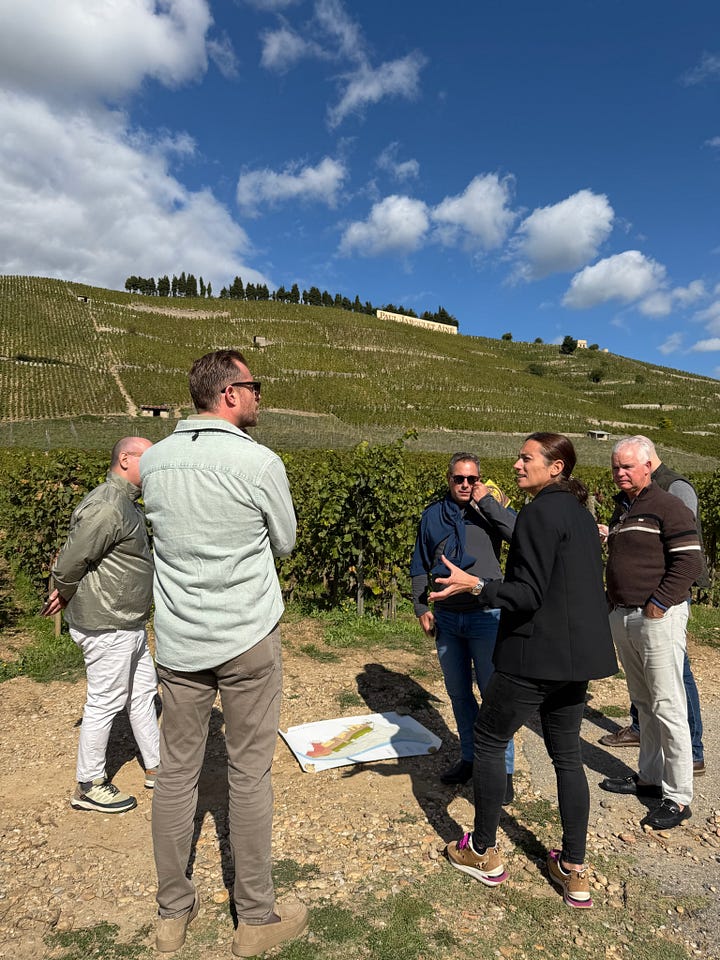
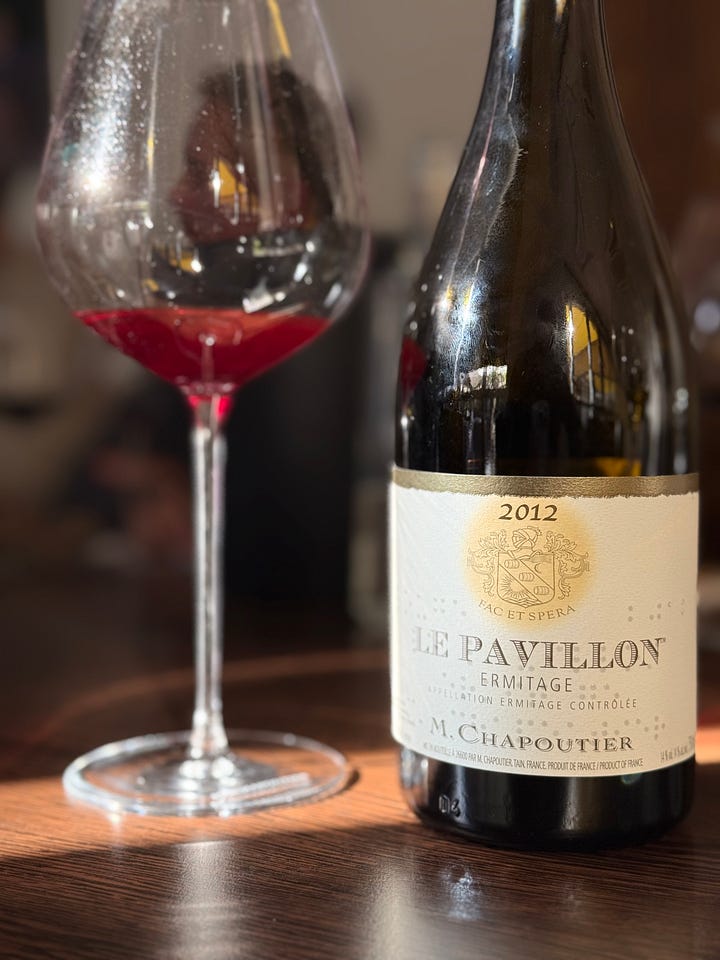
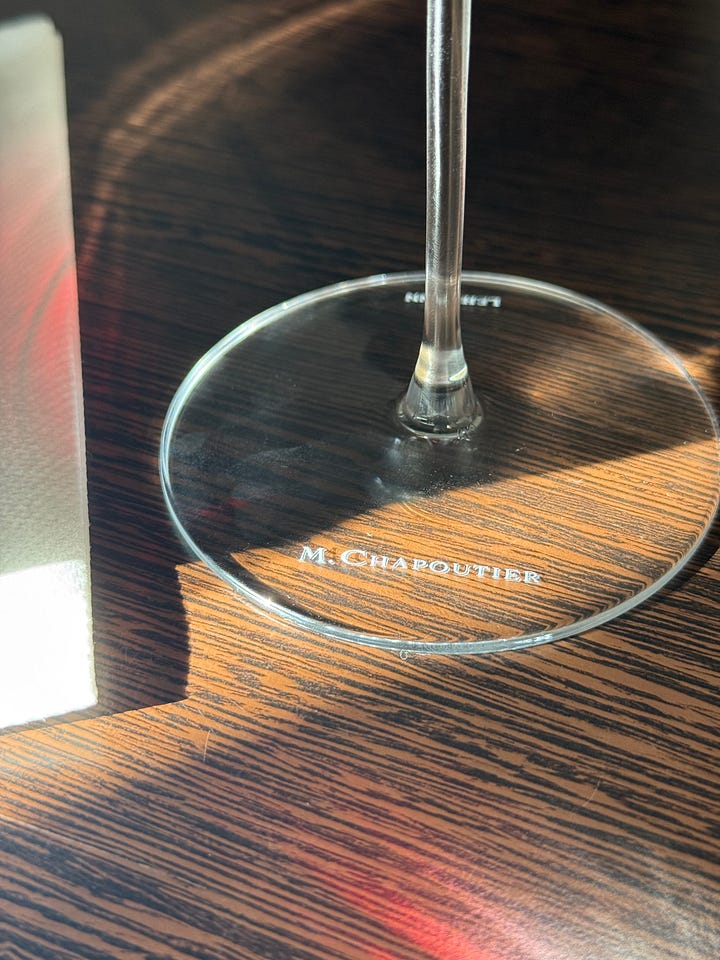
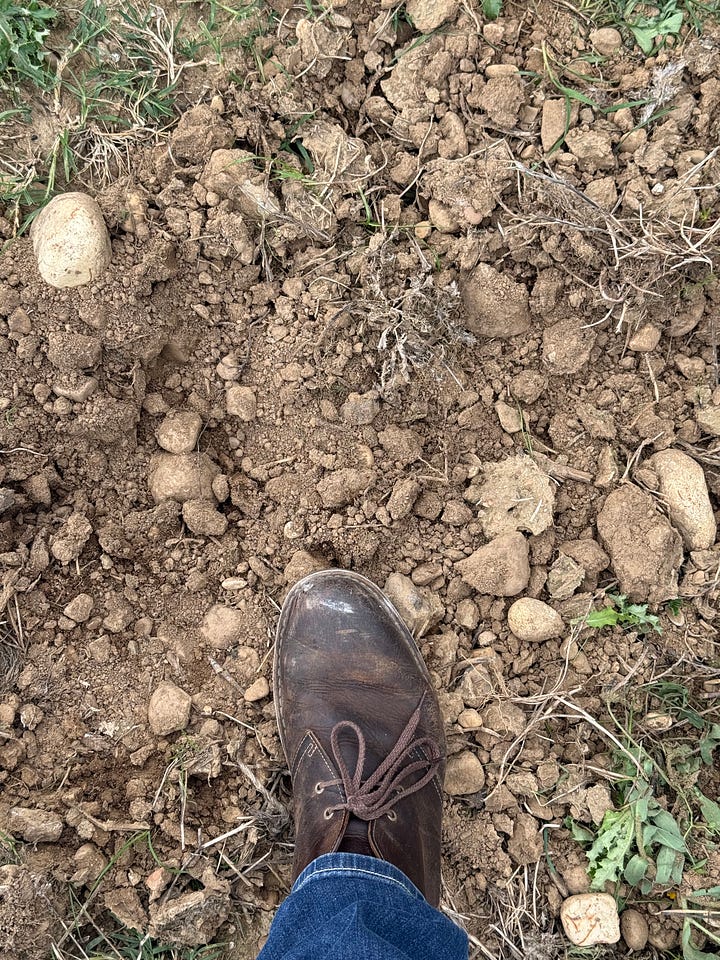
We can’t emphasize enough how important it is to visit wine regions. You can read all you want, but touching the ground, seeing the vineyard, and feeling the energy of the place is paramount to understanding the wine. After the lesson, we walked back to the winery to taste great bottles, two of which became Top Wines on the trip. Here’s the lineup:
M. Chapoutier Crozes Hermitage Les Meysonniers 2024. Entry level but solid white nonetheless that is a good introduction into white Hermitage. This is a 100% Marsanne (the OG grapes of Hermitage that were planted first BTW!)
M. Chapoutier St Joseph Les Granilites 2022 (white). Another 100% Marsanne but this time across the river in the steep slopes of St. Joseph. Marion explains St. Joseph produces more austere wines, and we’re here for it. This had amazing minerality and pull, so fresh and distinct with white flowers, peaches and pear.
M. Chapoutier Condrieu Invitare 2023. Is this the new Viognier 2.0? Forgot super oily, rich versions, this Condrieu is lean, fresh, yet not losing its aromatic flowery charm. This is the Viognier that’ll compete with the current Sauvignon Blanc craze.
M. Chapoutier “Haut Chamblard” St Peray Single Vineyard 2023. Bitterness is not an insulting tasting note. But it can sound like it, so Marion made an adjustment: NOBLE BITTERNESS. “Without it, the wine would be very heavy,” she added. Marion recommends to pair with seabass and provence herbs. This is 100% Marsanne and has hints of almond, citrus and sweet baked spice.
M. Chapoutier Chante Alouette Hermitage 2021. Another 100% Marsanne with blends of terroir from Le Meal, Ermite, and les Murets. The leanest Marsanne in the group and very elegant.
M. Chapoutier De L’Oree Hermitage 2014. Wow. We just went to the stratosphere! This 10+ year white was an absolute GEM. Grilled lemon, sweet almond, long finish, high acid…like a pineapple sweating over an asado in the mountains. Six month lees aging, 70 year old Marsanne vines, intensity, golden hue, softly spoken. Take. My. Money.
M. Chapoutier Sicamor Crozes Hermitage 2022. Onto the reds, this was like the entry Delas, fruit forward, lots of black pepper, and velvety tannins.
M. Chapoutier Les Granilites St. Joseph 2022. We’re all on the St. Joseph train by the time this bad boy gets poured. This wine is loaded with bright, ripe cherry. The acid, alcohol and tannins are all in check. This wine is ready for liftoff and so good. This is all Syrah no brakes.
M. Chapoutier Cornas Temenos 2022. Cornas is juicy as hell. And this Temenos is no exception. Roasted black fruit compote, soft big tannins, and a balance of freshness and power that just won’t break. Pour this for your guests and watch them melt like butter.
M. Chapoutier Sizeranne Hermitage 2020. Remember Maurice de La Sizeranne? This wine is a blend of terroirs: Le Meal, Greffiere, and Les Bessards. It’s lighter than the other Syrahs we tried, but the spices are on full throttle.
M. Chapoutier Le Pavillon Ermitage 2012. This is what Romeo & Juliet poisoned themselves with. JK. But seriously, if you’re gonna poison me do it with this wine. My goodness. Notice that the ‘H’ in Ermitage is missing in the wine name? That’s on purpose. M. Chapoutier takes the H out in order to express that this is a SINGLE VINEYARD HERMITAGE from Les Bessards. This is pure Rhone. Meat, bacon fat, black olives, violet, intoxicating flower perfumes, silk body, black fruit, and epic finish. This was the Wine of the Day, along with the L’Oree. Bravo!
Following a lovely afternoon with Marion and the iconic wines of M. Chapoutier, we decided to take advantage of the fact that we were at the base of Hermitage, and went for a hike up the steep hill. Stephen got a bolt of energy from the tasting despite the jetlag, and led the group in his designer black boots. The only one with the right footwear was Matt, who brought his On Clouds in a bag.
The Hermitage Hike was one of the top highlights of the trip. As we walked past the vineyards, where each vine is on its own peg to protect it from the strong winds, we noticed the light slowly change to its golden color. The town and river behind us became smaller yet clearer as we went up in elevation. The slight buzz of Syrah helped us push through the steep, stone path, and we took some breaks at nice viewpoints that led to the famous Chapelle Saint-Christophe, a small chapel believed to be built by a famous knight in honor of Saint Christopher in the Middle Ages. This knight was the ‘hermit’ of the hill, hence the hill’s name: Hermitage.
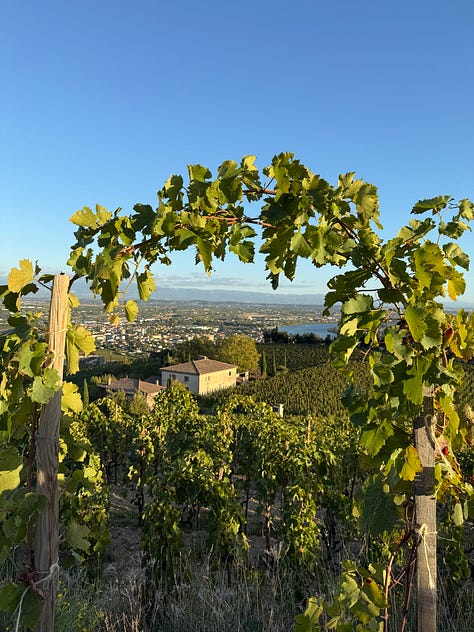
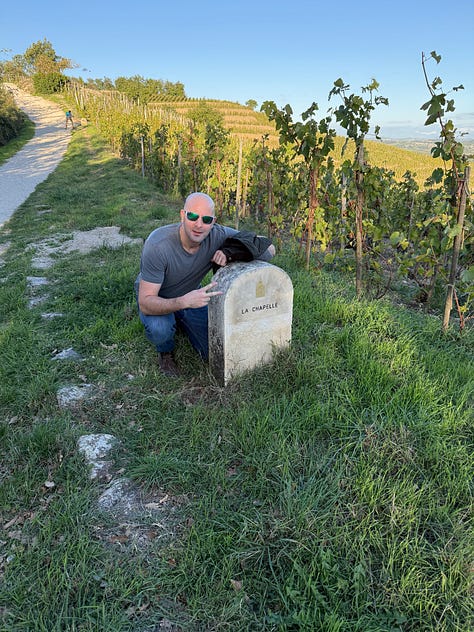
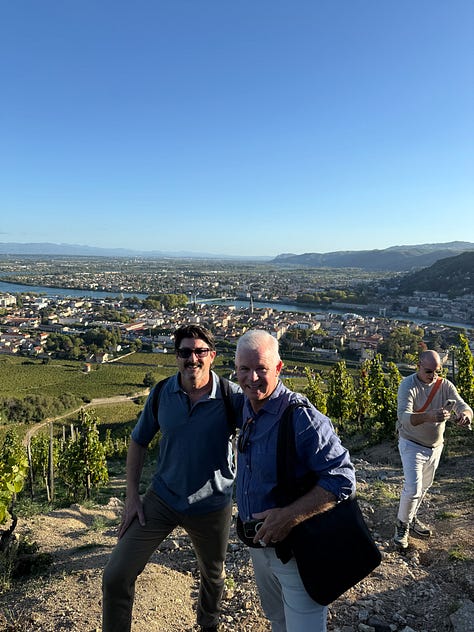

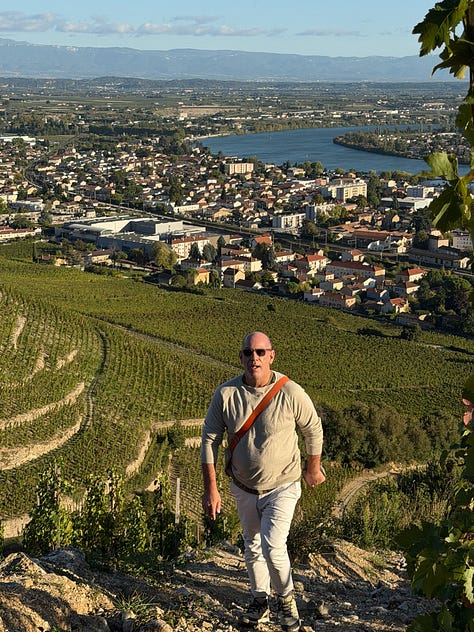
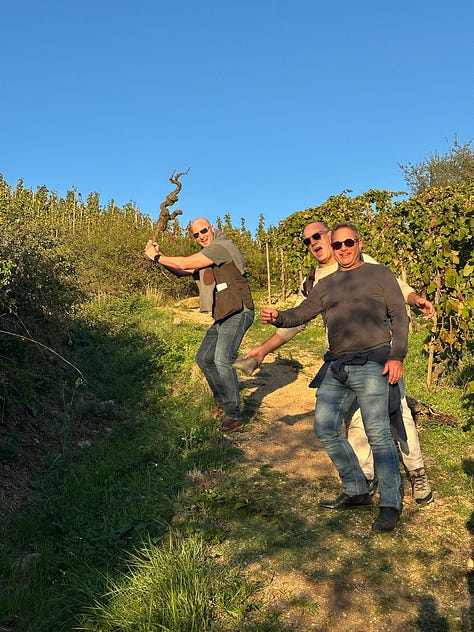
We traversed the ridge of the hill where we passed the most iconic vineyards at the very top such as Ermite and La Chapelle. On our way down, we got a bit lost…in a good way. We walked various paths that led to dead ends, and even one that got us to the front door of Jean-Louis Chave! We were more interested in asking for a taste of the 1990 Hermitage instead of directions, but instead decided to press on as darkness was creeping in. It turned into a two hour hike that burned off all the wine we drank. We ended the day eating dinner together at Brasserie le Tainois, and went back to the hotel to prep for an even better day two.
Day Two - October 7
Our black Mercedes sprinter was sitting in front of the hotel at 8:30am, ready to take us to the town of Ampuis, home of the famous Côte-Rôtie. On the one hour drive, we took turns choosing songs rotating through Grateful Dead jams, Billy Joel hits, Led Zeppelin, and French songs that fit well with the theme of the trip.
Unlike Hermitage which is mostly south facing, Côte-Rôtie aka “Roasted slope” has steeper, sun-drenched hillsides that are mostly southeast facing. The appellation is home to famous terraced vineyards built by the Romans. If you’re afraid of heights, we don’t recommend driving up the hillsides…it’s insane. The appellation is divided into two main sectors, each with distinct styles: Côte Brune (the “brown slope”), home to darker, iron-rich schist soils that produce powerful, structured wines with more tannin and longevity, and Côte Blonde (the “blonde slope”), that has lighter, pale granite and gneiss soils that make wines are more elegant, perfumed, and supple. Both are built to last.
Our first stop was Guigal, probably the most famous producer in Cote Rotie. Back in January, we tasted a fleet of their LaLa wines: La Landonne, La Turque, and La Mouline (recap here). It was some of the best wine we’ve ever had, so you can understand the excitement in our veins. Founder Étienne Guigal began working in wine at age 14 for Vidal-Fleury (another historic Rhône producer he ended up buying in 1986) before founding his eponymous domaine in 1947. Etienne’s son, Marcel, took over in the 1960s and was instrumental in elevating the Rhône’s international reputation. It was an honor for us to meet him at the winery before our tour.
At 82, Marcel explained to us how involved he still is with the 10 million bottle operation. His son, Philippe, (third generation) runs the estate, but Marcel put in 20-hour work days during the 2025 harvest. “Life is beautiful,” he reminds us in a soft voice filled with experience. He also told us how important it is to taste wines from around the world. “To increase quality you are obliged to taste all wines.”
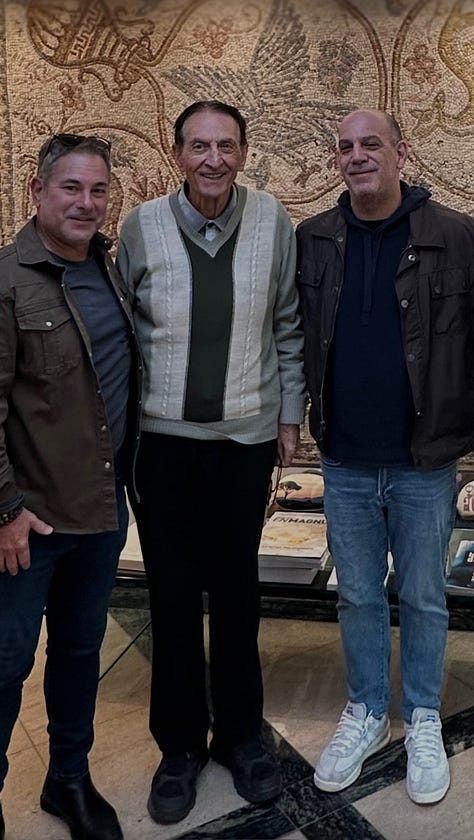
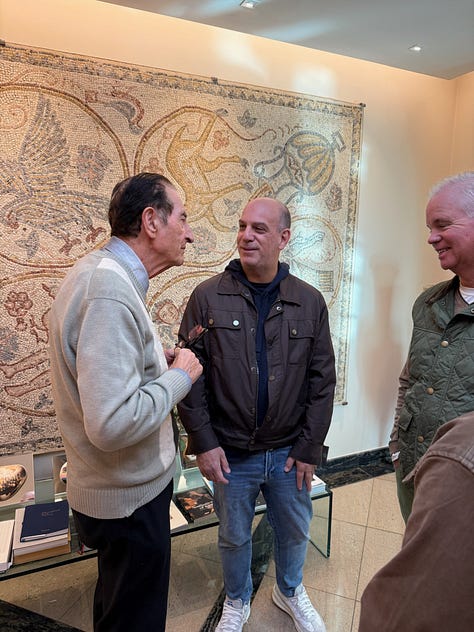
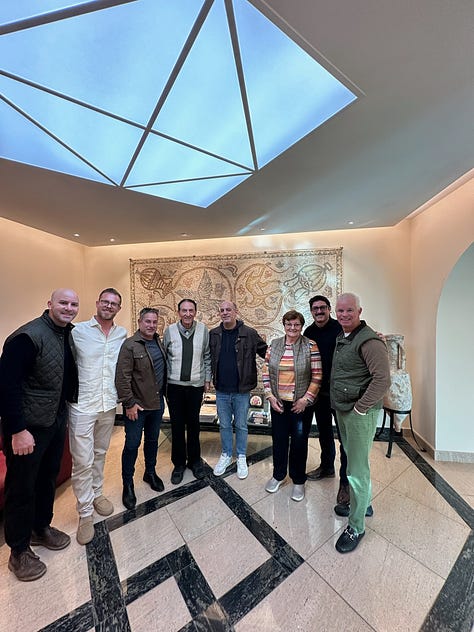
Our guide, Camille, showed us through the historic cellars of Guigal. We walked through a maze of pre-WWII underground tunnels (a common theme among all the wineries we visited), sneaking under roads in the city and feeling the still, humid air clinging to our coats. Barrels of La La wines stood before us, and it’s crazy to think they sit in there for years before going into bottle. It shows you how much of a long game wine is. Each bottle is a blend of grapes and patience.
After dodging a few fast-moving forklifts that were filling trucks with wine, we made it to the Guigal bottling line, which was a show we couldn’t miss. Giant robotic arms filled 12-bottle cases of wine destined to shelves all over the world. They moved fast and precisely, filling box after box in an efficient manner. Etienne started the winery, but it was Marcel who made the business scalable in our eyes.
After the tour of the winery, we traveled back with Camille to Le Caveau du Chateau, where the tasting session started. Camille was generous enough to give us a great look at the winery’s operation from Chateauneuf du Pape in Southern Rhone to where we were in Cote Rotie:
E. Guigal Condrieu La Doriane 2023. This goes back to classic, full bodied Condrieu with its rich oily texture propped up by 100% new French oak. Orange blossom, honeyed flowers and toasted spice take over here.
Château de Nalys Châteauneuf du Pape White 2021. This Roussanne/Grenache had great verve to it, and features aromas of white flowers and citrus with a full body. Southern Rhone to the max!
E. Guigal Ex Voto Hermitage 2019. Top wine of the trip hands down, the Ex Voto is incredibly unique in flavor. It is a treasure of Guigal only made in top years, with a nose that bursts out of the glass with acacia flowers, honey and toasted lemon notes. We bought one for the train to Reims.
Château de Nalys Châteauneuf du Pape Red 2019. This Grenache, Syrah, Mourvedre (GSM) has intense aromas of black cherry compote, dried fig, cracked pepper, sandalwood, and lavender. Another favorite in the lineup.
Domaine de Bonserine Cote Rotie La Garde 2020. This was a great bottle that showcased powerful structure but youthful energy, rich bouquet of blackberries with a dash of spices and floral notes too. One for the train to Reims please!
Vidal Fleury La Chatillonne Côte Rôtie 2018. Vidal Fleury is close to the heart of Guigal, and literally down the street from the winery. This bottle has elegance written all over it, medium bodied and well integrated for a good depiction of the region.
E. Guigal La Mouline 2021. Lucky to open one of the epic La La wines! This La Mouline had it all: Intense aromas of red berries, violet, and a hint of bacon fat. The mineral edge at the end didn’t hurt either.
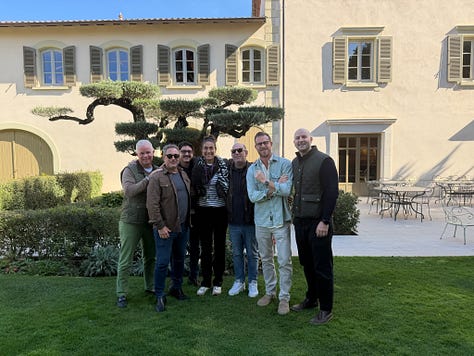
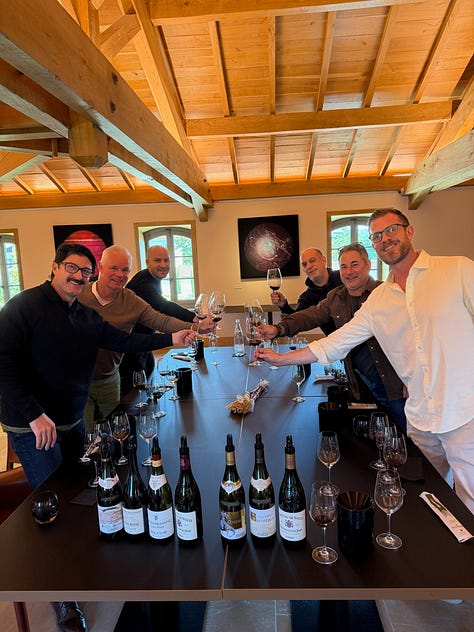
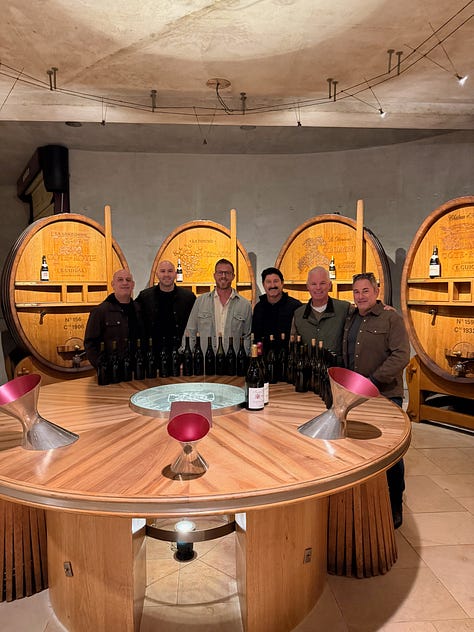
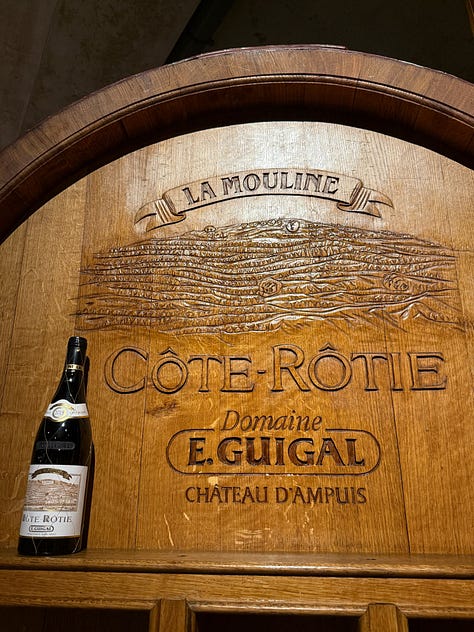
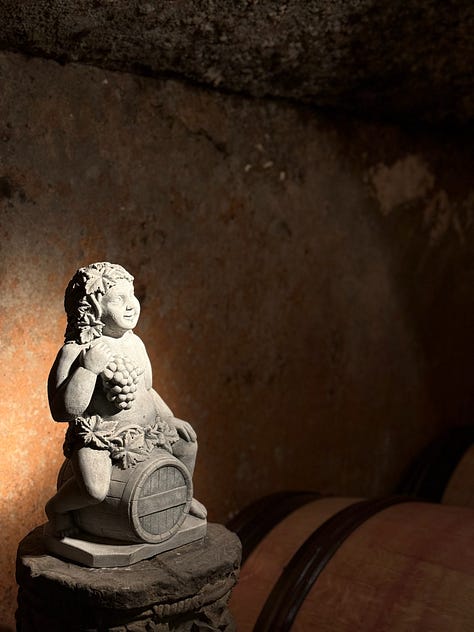
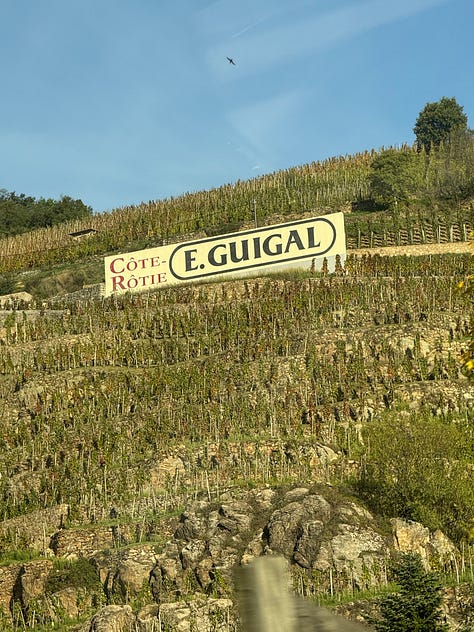
Following Guigal, we got lunch at down the road at Le Bistrot à Vin de Serine, where we enjoyed a beautiful Jean Michel Gerin Cote Rotie Champin le Seigneur 2018. We tasted Jean Michel’s 2007 La Landonne at our November Rhone tasting back in November 2023, and wanted to revisit it. Through our conversations with winemakers, we realized that 2021 was a poor vintage in the Northern Rhone. The prices reflected this too in a drastic way. Jean Michel’s 2021 was 30 euros less than other vintages! If you know Cote Rotie, you know it needs some time, so we decided to open the 2018 at this highly recommended restaurant which hit the mark. The wine was fresh, loaded with bright strawberry and black cherry, along with white pepper. A good pick me up for the next visit which would become unforgettable.
We drank lots of water as we waited for our next host to meet us at the bottom of the Cote Rotie slope: the Great and Legendary Stephane Ogier. The Ogier family has been in Ampuis for seven generations, selling grapes to esteemed wineries. It was Stéphane’s father, Michel, who started harvesting those grapes to make wine under their family name. In 1997, after completing his oenological studies in Beaune, Stéphane formally joined the family estate. The domaine produces wines from 27 acres of vineyards in some of the most famous Côte-Rôtie areas, such as Lancement, Cognet, and the best spots of Cote Brune and Cote Blonde. Stephane is the single vineyard King of the northern Rhone. Plain and simple.
Jeff had been in contact with Stephane for over a year as we tasted his wines, along with his father’s, plenty of times before arriving here. It’s rare to have a legend such as Stephane so accessible to wine lovers like us. It seems like we got a lucky break as he had just finished harvest (you could tell by his purple-stained hands) and had some down time to show us the steep vineyards and soils of Cote Blonde and Cote Brune, and his winery that faces Le Goutay vineyard.
In the early 2000s, Stephane explained that he wanted to use every dollar to buy up vineyards on Cote Rotie. He has a strong vision, and expanded within his means in a very smart way, taking every step carefully but doing so with confidence in the vineyard’s potential. Back in the 60s and 70s, the land here was very cheap. Owners would sell the land close to the river, and offer the steep, hillside vineyard land on Cote Rotie FOR FREE (crazy right?), incentivizing people to cultivate these harsh, difficult plots. For every one worker on the plains of Crozes Hermitage, you need 10 on Cote Rotie to give you a picture of the labor challenges. So Stephane kept expanding the portfolio and focusing on expressing these single vineyards one by one.
Our goal on the trip was to taste one barrel sample. With Stephane, we lost count of how many we tasted. Our group of seven walked down to his barrel room glass in hand and surrounded a big barrel on its side. Barrels and barrels of wine towered over us and we felt isolated from the rest of the world and only in Stephane’s world. One by one, we tasted barrel samples of single vineyard plots from the 2022, 2023 and 2024 vintages, all of which won’t see store shelves for a while until Stephane feels they are ready to be released. And later on, we checked in on the 2025s that had just finished fermenting, including the inky and powerful La Belle Helene. We also got some inside scoop on Stephane’s Mon Village wines, which make up half his production and blends several single vineyards into one bottle. Remember we mentioned Rhone 2021 was a poor vintage? Well, Stephane decided to blend his top shelf single vineyards into Mon Village that year, offering in-the-know wine lovers a taste of his best plots in one of his more accessible wines. Some highlights from the barrels:
All of the La Belle Helene’s from 2023, 2024, 2025 (tank) were magnificent and showed a common theme of monstrous power and rich flavor. The wine is made from 100% Syrah and comes from 0.5 hectares of vines planted in Cote Rozier, not far from the parcels used by Guigal for their La Landonne. The vines are nearly 100 years old, combine that with a small plot, and you get very small quantities (Cote Brune side). They are the most ageworthy of the bunch. Only the Syrah Whisperer can tame this beast.
The single vineyard Lancement 2023 and 2024 were outstanding and so pure. “Lancement” refers to a specific single-vineyard or parcel wine from the Côte Blonde side of Côte Rôtie (the granitic, lighter-soiled side of the slope). The layers of fruit from one grape, the bold tannins that cling to your gums, and the beautiful mineral elegance give this a serious thumbs up.
Holy cow lest we forget the Cognet 2023 and 2024! The wine sings with fresh violet, black cherry, and rose petals. It is a stunning portrait of Cote Blonde, one that belongs in The Louvre for its sheer beauty and light, and its ability to attract attention for hours in the glass. I’d rather have a glass of Cognet than an hour in an empty room with the Mona Lisa.
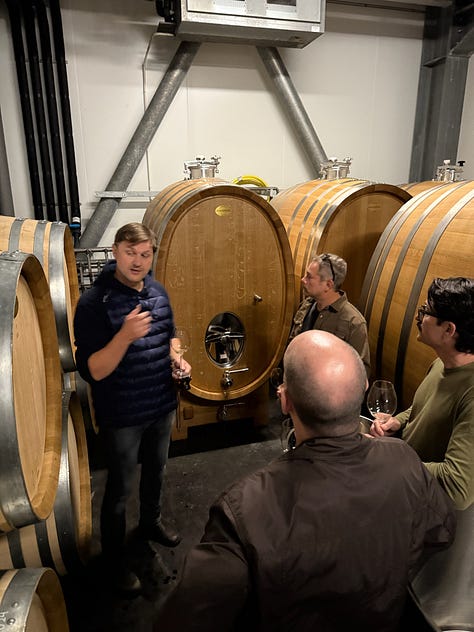
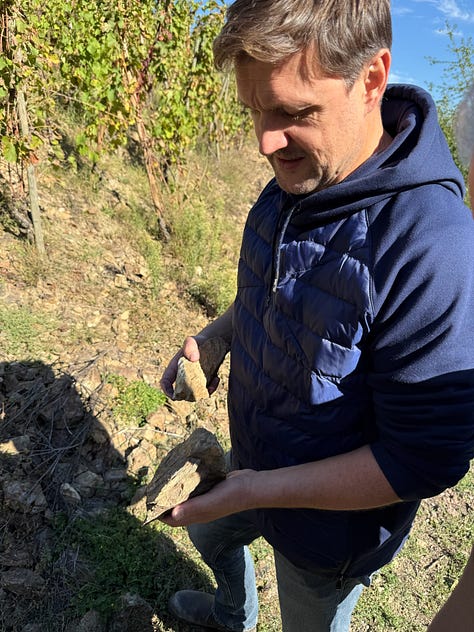
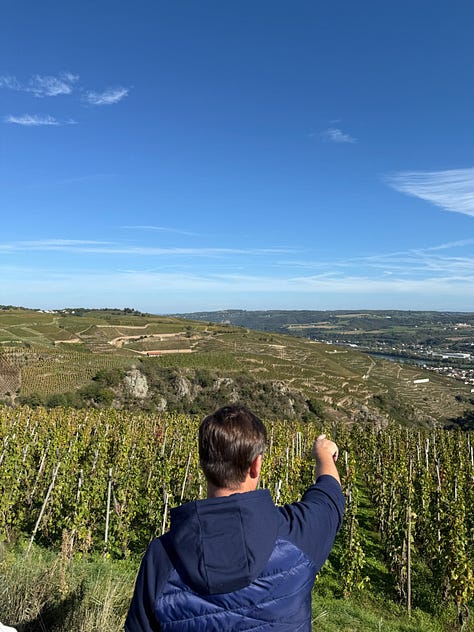
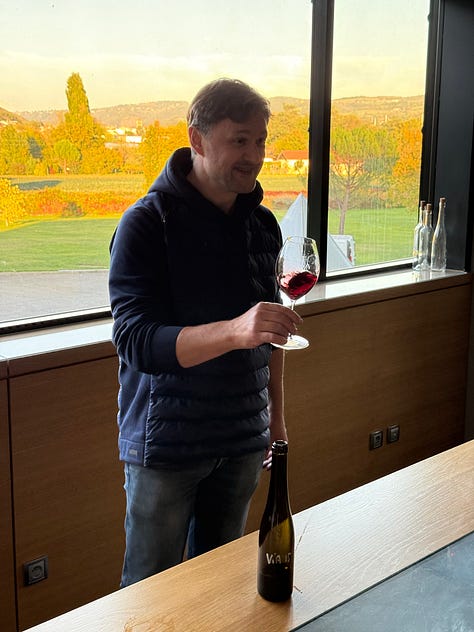

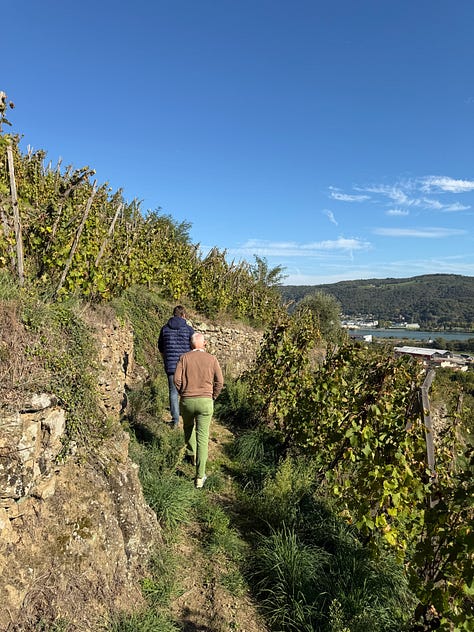
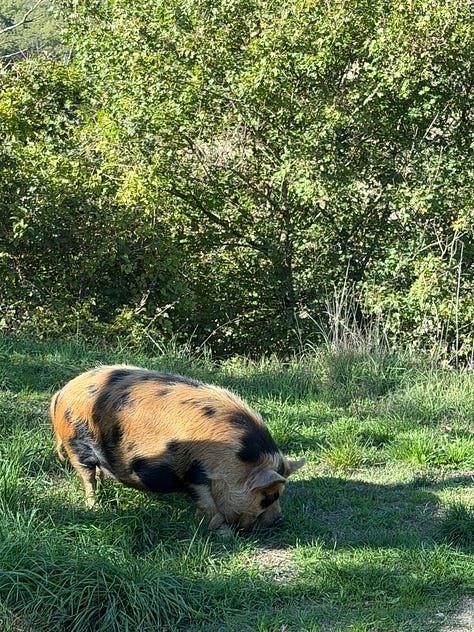
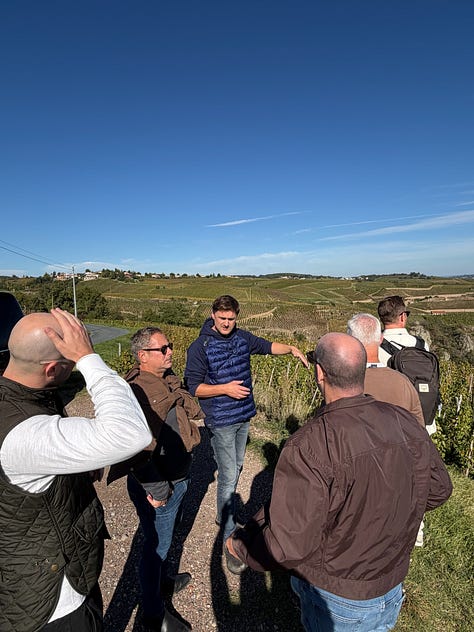
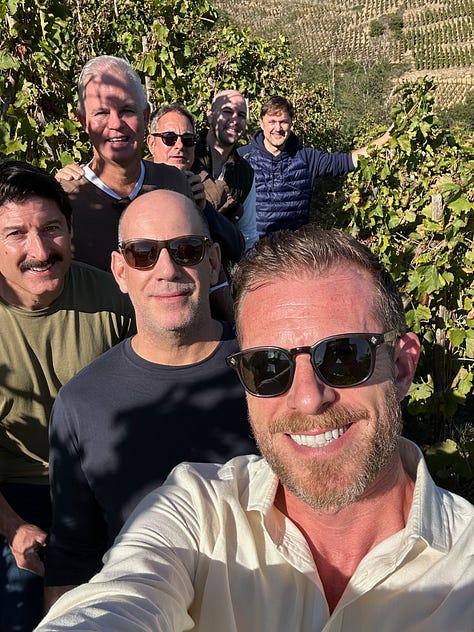
The next chapter of Cote Rotie has Stephane Ogier written all over it. Anyone who tastes his wines can feel the purity of each vineyard he captures, stripped of all unnecessary features but Syrah itself and the place it is born. Like the architectural works of Ludwig Mies van der Rohe, form and function join in spiritual union to create “wines of place” that everyone loves to talk about. From Lancement to Cognet to Collet to Le Champon, we traversed the entire Cote Rotie hillside, each of us commenting on the singles we enjoyed most. The inky, fresh, young wines already had their stamp and structure.
Stephane is the winemaker we got along with the most. He felt like one of us from the start, sharing good stories about his travels, cracking jokes, and educating us along the way. He’s a family man with three young kids and a winery with so much demand that entertaining guests feels like a respite from dealing with distributors and excel sheets rather than a need to sell to collectors. We asked if his father is proud of the wines. “He hasn’t said much, so that means he is proud,” Stephane jokes about his old school mentor.
After tasting at the winery downstairs, we walked back up the stairs and peered out the long, clear windows that showed Cote Rotie’s magnificence as the sun set behind the ridge. Along the lower shelf opposite the windows, one can see all the empty bottles, or memories, Stephane opened along his wine journey. The only things moving outside were the tree branches and an automatic lawn mower with a lot of work to do over the spanning soft grass lawn.
Before heading out, Stephane came back into the room with a bottle of 2010 Stephane Ogier Cote Rotie Lieu-Dit Champon. He opened it with a genuine smile, knowing he was unleashing the kraken upon us. Upon putting my nose in the glass, I looked at Matt who did his signature simultaneous glass and eyebrow raise and said, “This is it.”
We were in a dream. The 2010 Champon is something out of the deepest soul of mother nature. A secret she holds for those who earn her trust. Waves of euphoria covered in smoldering black fruit and baked spice intoxicate your senses and overwhelm the palate in pleasure. It is the pinnacle of wine, the best it can possibly be. It makes sense why the Romans planted vines here. It makes sense why Stephane bought land here. It makes sense why one of Stephane’s kids will carry on the legacy. The answer is here, in this glass, that can invoke our purest emotions through taste. This was unequivocally the wine of the day, and one of the Top 10 wines I have ever tasted in my life. Similar to the 2007 La Turque we tasted earlier this year, it left us all speechless. 101 points!
We spent close to five hours with Stephane, and his generosity will never be forgotten and only retold again and again. Ogier is the name to know in the Rhone Valley.
We ended up buying a bottle of the Stephane Ogier La Belle Helene 2005 to taste back in Miami and celebrate our 20th anniversary again. Stephane gave us the blessing that the wine is ready for liftoff. We said our goodbyes and jumped in the van to make our 8pm reservation at Bistro Andre in Valence, home to one of the biggest lists in France under the leadership of sommelier Paz Levinson. Our fatigued palates took one last leap: the G. Roumier Clos de la Bussiere Morey Saint Denis 2013. Each of us drank a glass over the course of two hours since the wine needed serious time to open up. A beautiful color and cherry aroma emanated from the glass. It quenched us more than water ever could.
Day Three - October 8
You could call it recovery day, but to us it was travel day. Just as we came into the Rhone, each of us made our own plans to end the day in Reims, the capital of Champagne. Matt and Stephen took the early train to explore the markets of Lyon and take down Oysters by the dozen. Some of us slept in and bought some more wine for the plane ride home. We all met up at the Lyon train station where Matt and Stephen secured provisions for the evening train ride from Dijon to Reims, which would take close to four hours. We still had to take our second train from Lyon to Dijon though, and that’s when things went sideways. David had bought his ticket the day of at the Tain L’Hermitage station, but the ticket office got him the wrong train. For some reason, French police were packing every car, seizing threats before they turned into action. Seconds before the train departed Lyon, police and SNCF staff asked for David’s ticket and noticed he was on the wrong train. David was kicked off immediately and we had no idea what to do. We even bribed the police with our Guigal Ex Voto 2019 but they refused. Matt even offered a rare antique map of Rhone to the cops and staff, but no dice. As the train moved silently, we called David to make sure he’d get on some train to make the Dijon-Reims connection.
“I got on a train that supposedly arrives right after you guys,” he texted us. Phew. One missed train could land you a night in Beaune if you aren’t quick. Not that that’s a bad thing. Once we reconnected in Dijon, we opened the E. Guigal Ex Voto White 2019 and Domaine de Bonserine La Garde 2020, along with a blind tasting of the mini bottles Matt and Stephen kept from the Air France trip.
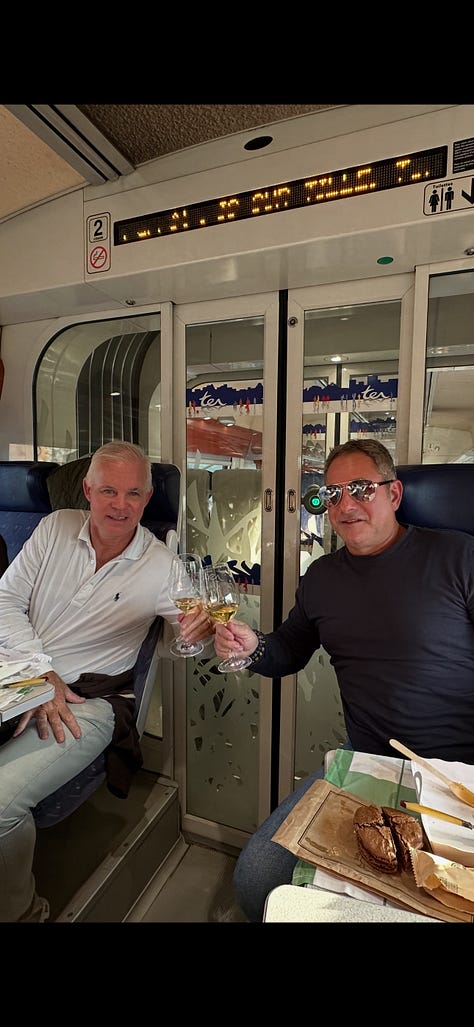
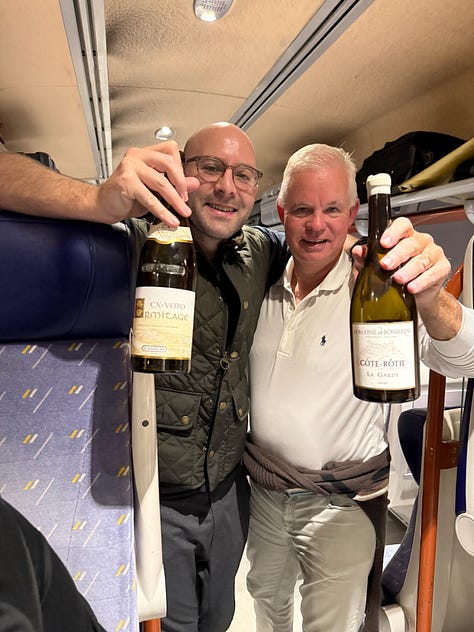
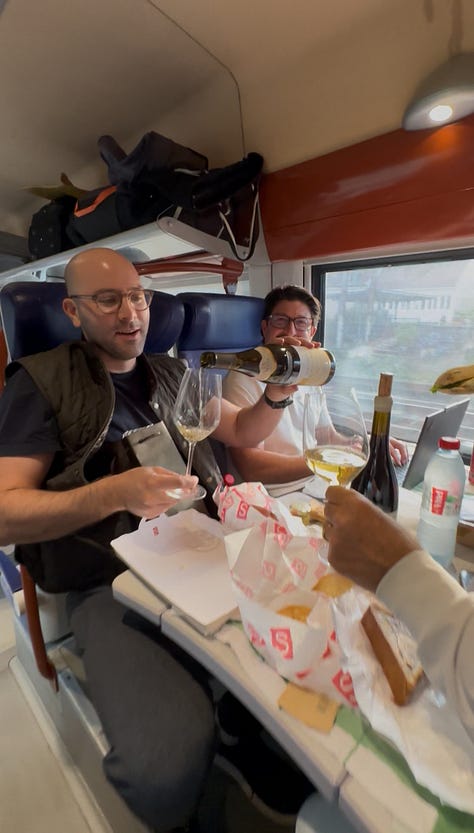
The seats weren’t assigned, so we managed to grab two 4-seater sections side by side with a table in the middle. A french teenager sat in one of the seats. The entire train was empty but he insisted on sitting in his seat. So the entire ride was a bunch of empty seats, seven rowdy wine lovers, and one young dude watching tik tok as we chatted and drank out of wine glasses. These are the moments of the trip we’ll never forget. It’s what makes traveling with friends so important because that is where bonds grow stronger. We just laughed and drank our way to Champagne, seeing the slopes of Burgundy whizz by us and not paying attention to the darkening of day.
Day Four - October 9
Matt, Stephen, David and Andrew stayed at a hotel right around the corner from the Airbnb where Jeff, Jesus and myself were. It was a cloudy, misty morning, but very soon the clouds dispersed and the peaceful undulating slopes of Champagne were drenched in sunshine, unveiling the infinite swell of the French landscape. This was much, much different than the land of Rhone, not a terrace in site. All of our travels took us south of Reims, where Montagne de Reims, one of the five Champagne regions, boasts loads of Grand Cru sites known for Pinot Noir. The other regions are Vallée de la Marne, dominated by Meunier, offering fruitiness and approachability, then Côte des Blancs, home of Chardonnay, then Côte de Sézanne, also Chardonnay-based, but with softer, fruitier wines, and lastly Aube (Côte des Bar) –which is further south, closer to Burgundy; Pinot Noir thrives here.
Our first stop of the day was Château de Louvois, a Chateau Versailles-inspired estate filled with rich French history dating to the 17th century. In 1989, Champagne house Laurent‑Perrier acquired the estate to host guests and harness the influence of Louis XIV on the House’s flagship cuvee: Grand Siècle (translates to “Great Century” referring to the 17th century in France, known for cultural and artistic grandeur).
The hospitality of Champagne Laurent-Perrier cannot be overstated. It was the pinnacle of hosting. From the head butler Davide’s rehearsed movements that cut through the air around us with precision and grace, to the paintings, gardens, and architecture that enveloped our surroundings, we felt inside the walls of the Great Century.
Our host, Edouard Cossy, the global director of Grand Siècle, made us feel welcome from the start. Champagne in hand, Edouard leaned on the fireplace and explained the history of Champagne Laurent-Perrier, focusing on Bernard de Nonancourt, the man who created the Grand Siecle cuvee and turned Laurent-Perrier into one of Champagne’s most respected houses.
Bernard de Nonancourt was born in 1920 into the family that later acquired Laurent-Perrier in 1939. Inspired by Charles De Gaulle’s fiery words, Bernard fought in the French Resistance during World War II. In 1944, Bernard wanted to be in the tank regiment so badly that he made his officer, Lieutenant Galley, a serious offer.
“With a smile, I offered him 100 bottles of Champagne to satisfy my desire to fight in a tank,” Bernard said in his autobiography. “That story spread like wildfire: 100 bottles of Champagne to go and get yourself killed! Then, more seriously, I added that I wanted to avenge my brother and do my duty.” Bernard ended up becoming a sniper due to his height, which would leave him too exposed sticking out of the armor.
A few years after Germany surrendered (in Reims of all places), Bernard took charge of the house in 1948, at just 28 years old. Bernard was a young, obsessive taster with talent. His radical idea for Laurent-Perrier came 10 years later, redefining what a prestige cuvée could be. In Champagne, the top bottles are considered ‘vintage’, meaning all of the grapes are sourced from one exceptional year like the highly praised 2008 vintage. But Nonancourt rejected the idea that one harvest alone could ever represent perfection. “Only the art of assemblage can offer what nature can never provide, that is, the perfect year,” the House states.
Bernard’s revolutionary idea was to blend three complementary vintages, each outstanding but distinct, sourced only from Grand Cru villages, and combine them to achieve a level of harmony and balance that no single year could yield. Balance. Design. Construction. The first release was 1959, labeled No. 1, which comprises 1955, 1953, and 1952 vintages. Only two bottles remain today. The current release is No. 26 which blends 2012, 2008, and 2007 vintages. The Grand Siecle bottles are hard to miss, inspired by the 17th century swan-neck bottles of the day.
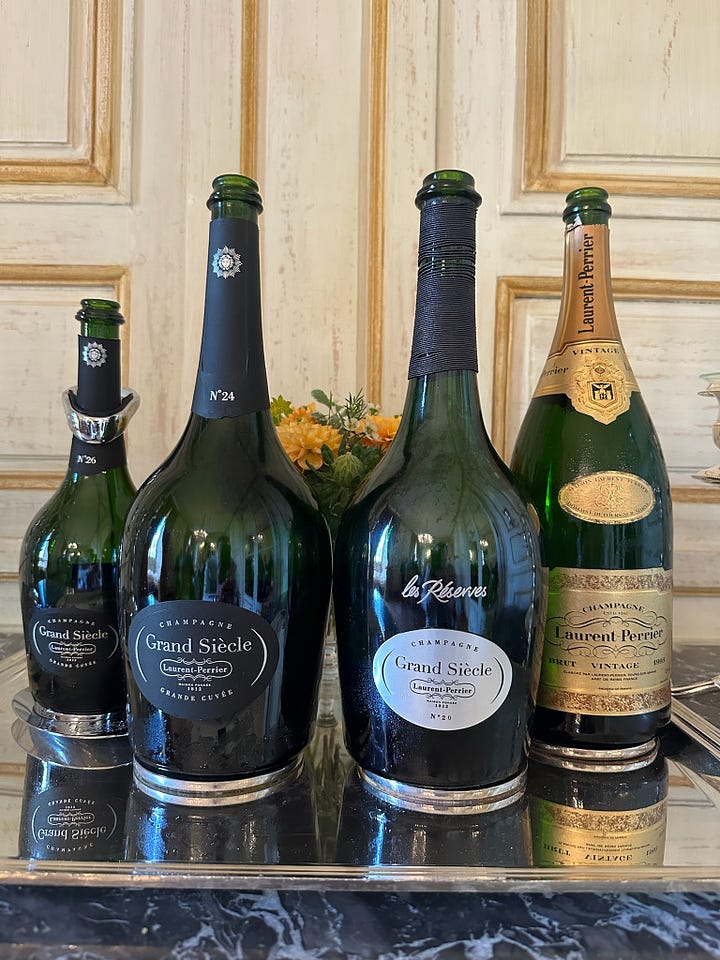
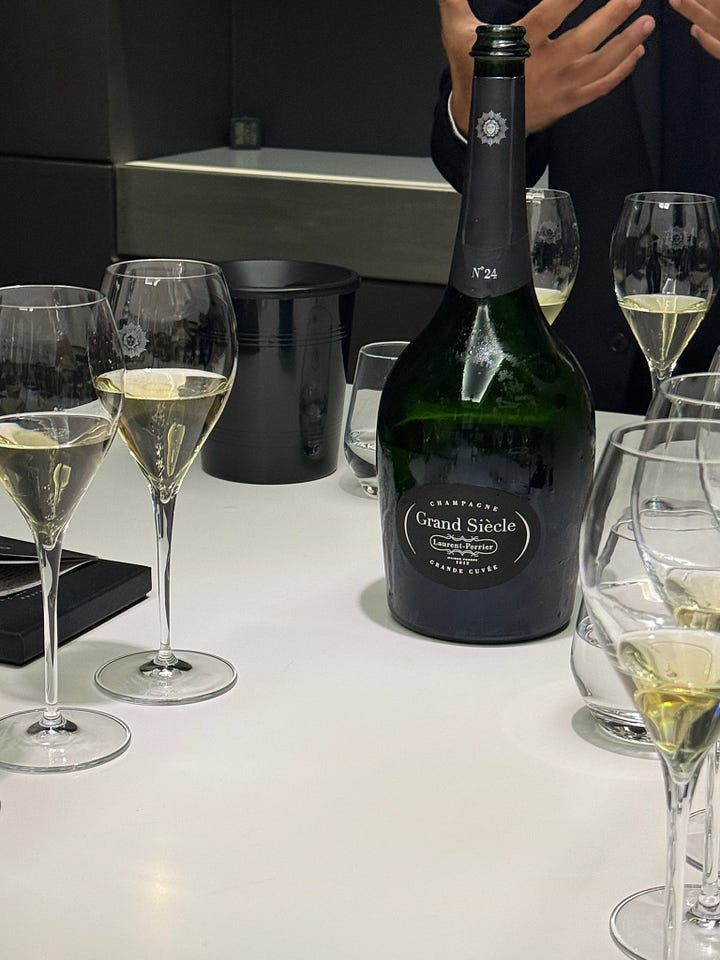
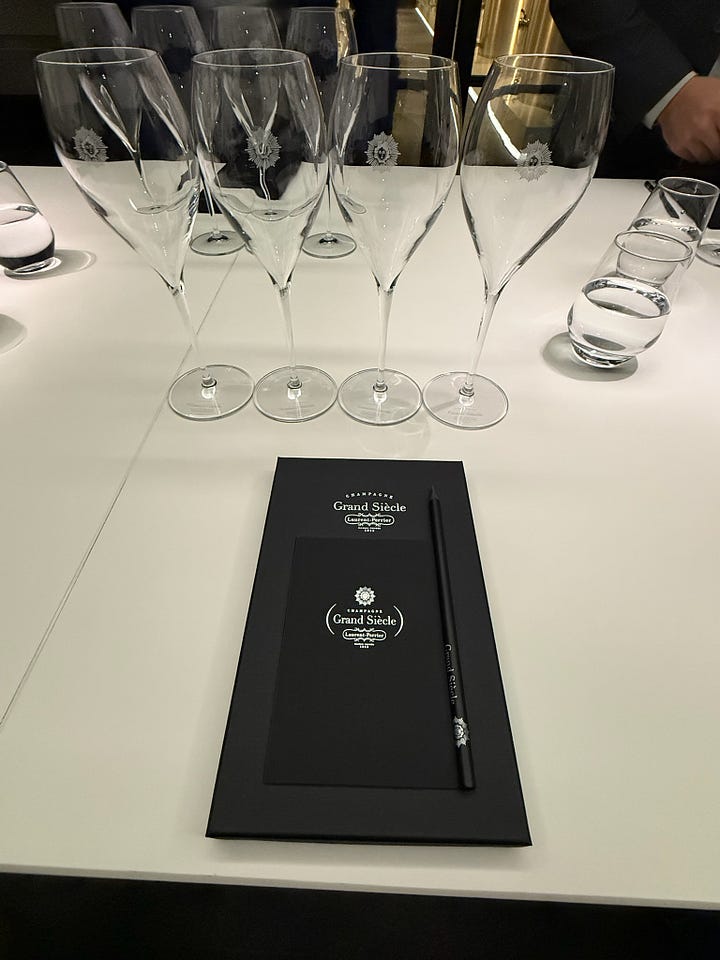
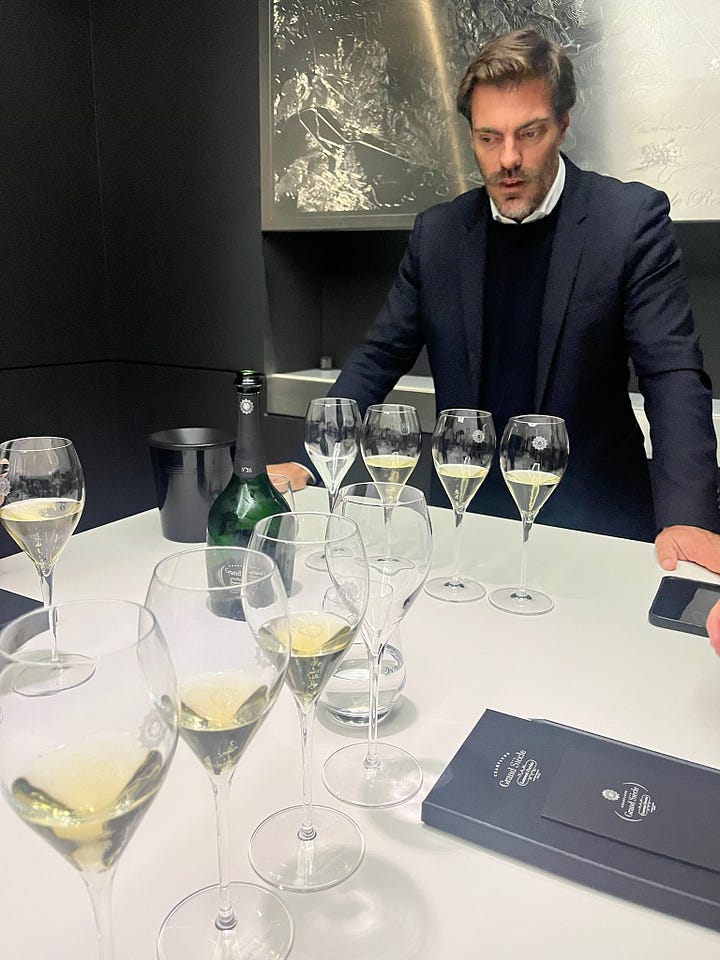
“One vintage can bring elegance, another tension and structure, and the other concentration of fruit,” Edouard said. “And the goal is to achieve what no single year can capture.” Next time you walk the gardens of Versailles, look at the symmetry of the tall shrubs, a straight line evenly distributed that goes for miles. This is the philosophy. Their raison d’etre as Bernard would say.
The result? What some of us believe to be the most ageworthy Champagne on the planet. A wine of steel. We tasted No. 23 in magnum earlier this year as part of our Champagne tasting, and even then we knew this wine had a structural focus unlike any other.
Following the story of Grand Siecle’s beginnings, we rode together through the slopes of Montage de Reims and stopped on top of a hill, surrounded by Grand Cru vineyards. To our distant left we could see the town of Bouzy, then to our right the famous Epernay. Just like Hermitage and Cote Rotie, standing at these vantage points gave us so much to learn. We took some great pictures, courtesy of our two Directors of Photography, David and Stephen, and continued to the cellars of Laurent-Perrier.
As our first stop in Champagne, we were stunned by the literal walls of Champagne bottles stacked horizontally on one another. The sheer weight of it all seemed impossible to comprehend. But above all, it was a beautiful site. These bottles stay like this for years, sometimes decades, in these long, humid, still tunnels underground. Wine is so much more than something we drink, but a world rich in history that enlightens the present. When you get the bottle at the restaurant table, most of us don’t really understand the journey it has been on. Being here deepens our respect for it.
After walking the tunnels and seeing the bottles being riddled to collect yeast toward the neck (where they will eventually be disgorged to make room for the second and final fermentation), we made our way to the tasting room. Before getting there, we walked a hallway of vertical stainless steel cylinders.
“Notice anything about them?” Edouard asked.
Each was one single piece of steel. No welds. Unbelievable. They look like rocket ships. The tasting room had one long table with four permanent silver spittoons built into the walls at the four corners. They looked like water fountains. The room, deep underground, is pressurized to make sure no outside smells or interference affect tasting. In other words, it’s where the cellarmaster works. Again, perfection. Only three colors made up the room: black, silver and white, so we messed up the Feng shui with our clothes, but we were temporary visitors in this permanent temple of Champagne. We tasted:
Champagne Laurent-Perrier Blanc de Blancs Brut Nature. Bang. What a start to our tour of the region. Pure, naked lemon, focused citrus aromas, and very light on the palate. But don’t be fooled, the common thread of steel structure was present. Really good.
Champagne Laurent-Perrier Millesime 2015. Again, this version was bright but heavier in citrus fruit concentration. A true crowd pleasing wine for big parties and dinners.
Champagne Laurent-Perrier Grand Siecle No. 26. Entering Siecle territory. This blend of 2008, 2007, and 2012 was like a steel beam. Waves of salinity, peach, orange peel, and pristine flavors weaved together in a tight structure.
Champagne Laurent-Perrier Grand Siecle No. 24. This 24 is outstanding. It is a blend of 2007, 2006, and 2004. It has that characteristic brioche aromas from the 10 years + of lees aging, then flavors of lemon cream and linear acidity. It is a ballerina with balance, structure, and effortless strength. Built to last forever.
Champagne Laurent-Perrier Les Reserves No. 20. Only one word can describe this: Epic. The Les Reserves line takes that same perfected blend and lets it age quietly in Laurent-Perrier’s cellars in Tours-sur-Marne for an additional 10-15 years on the lees before disgorgement, deepening texture and amplifying complexity. It’s not produced every year and in very limited quantities. This magnum comprises 1999, 1997 and 1996. I still feel the purity of lemon, brioche, toasted almond, flint, and flowers funneled into a long finish felt even writing this now. Drinking window? Until the end of time.
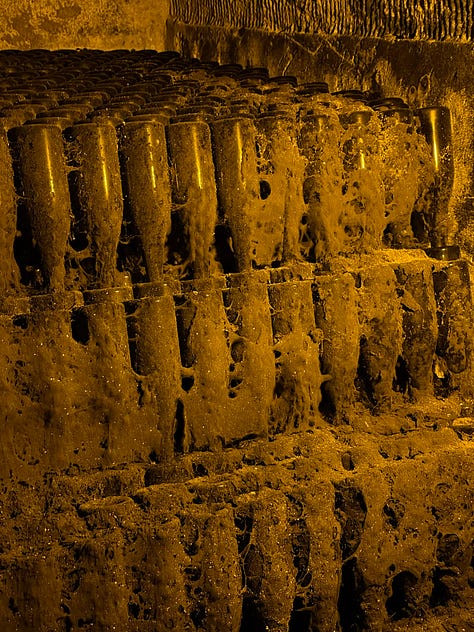
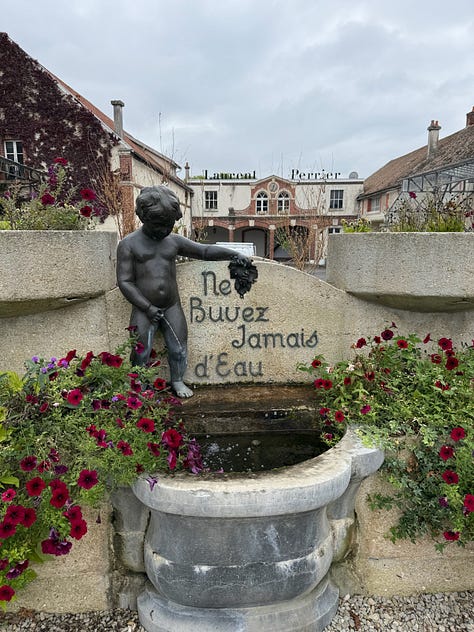
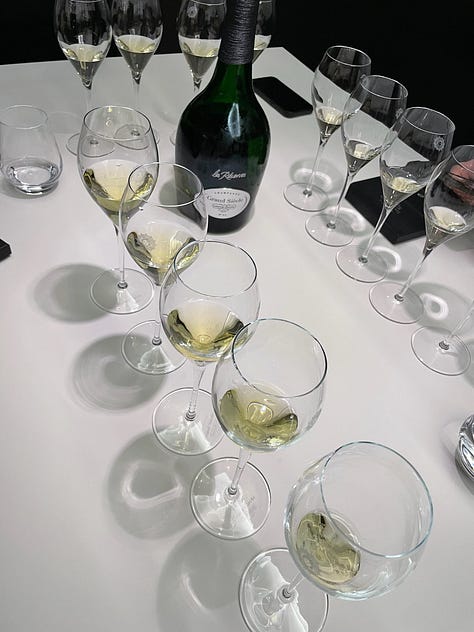
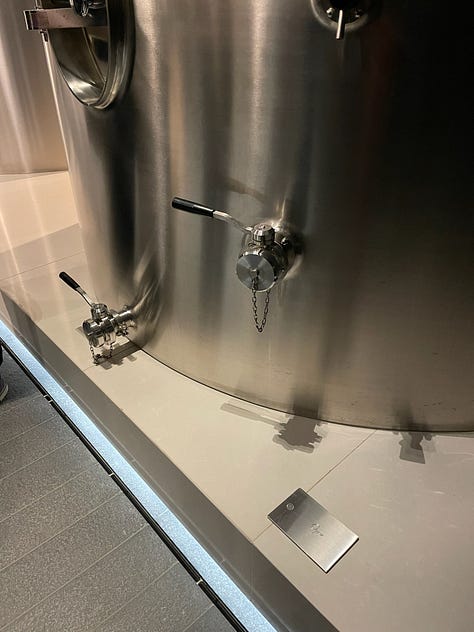
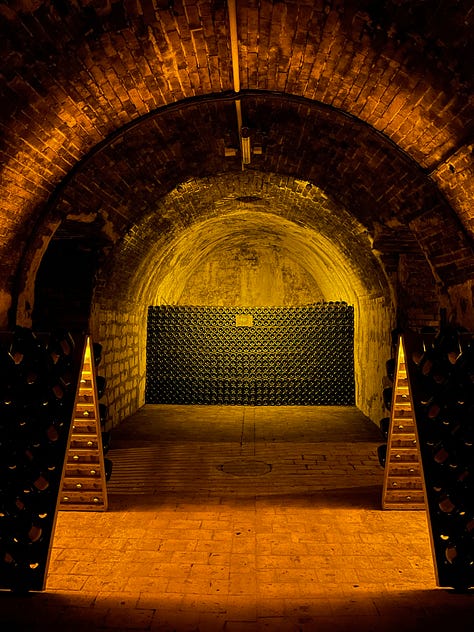
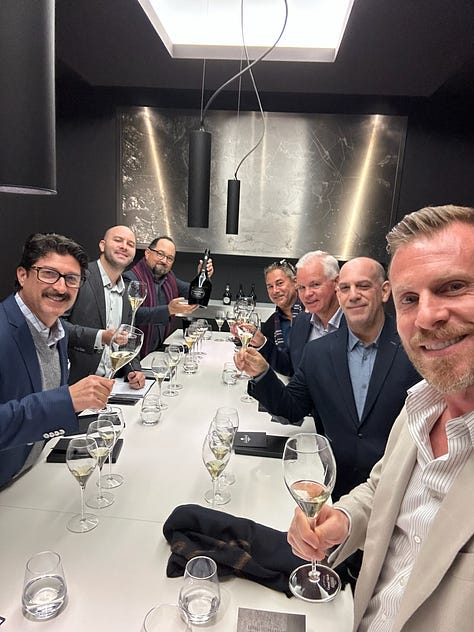
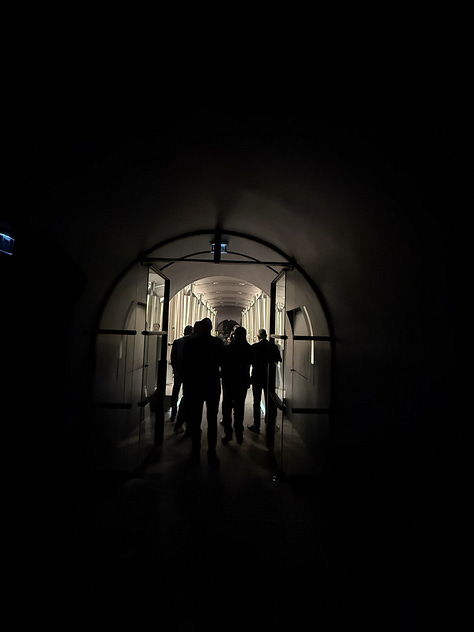
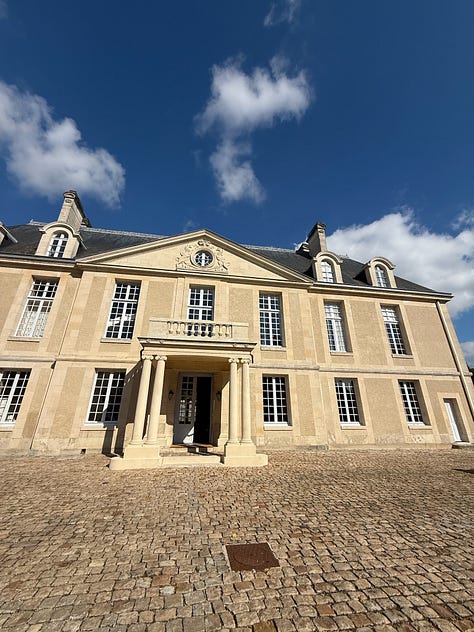
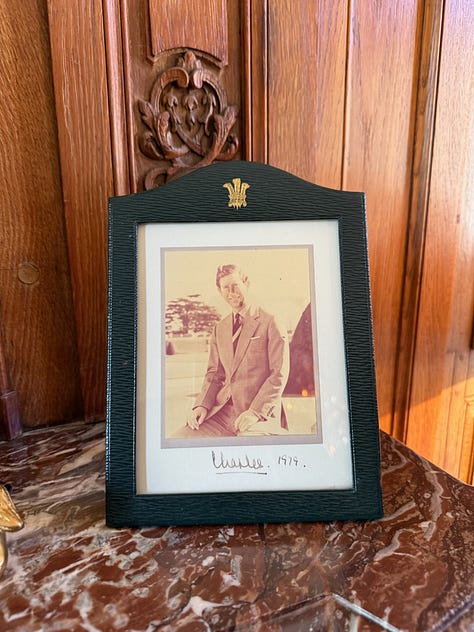
We could’ve been there all day not noticing the light changing outside. Luckily, we had some wine leftover for lunch back at Chateau du Luvois with Edouard. Davide was waiting for us with his assistant at the front door. I couldn’t help but think this was all a scene from Remains of the Day where Stevens and Miss Kenton take care of visitors, and this is their Darlington Hall.
We stood in the front room near the fireplace, tasting more of the No. 26 with light bites. Davide then opened the doors to the dining room where we sat together at a regal, oval shaped table to enjoy a three course meal from the House’s chef, Valerie Marchandise. The first course was Fines lamelles de noix de Saint Jacques, noisettes torréfiées (Thin slices of scallops with roasted hazelnuts) paired with No. 26, followed by a memorable Wellington de veau (veal Wellington) paired with No. 23, and finishing with Chartreuse aux poires (pear Chartreuse) paired with Laurent-Perrier Brut Vintage 1993, a final display of why this Champagne house is likely the most ageworthy on the planet. It tasted so bright, so fresh, and the bubbles had such power after 30+ years. “Bubbles act as a speaker to amplify the flavors of wine,” Edouard said. These bubbles don’t quit, they deliver at young or old age.
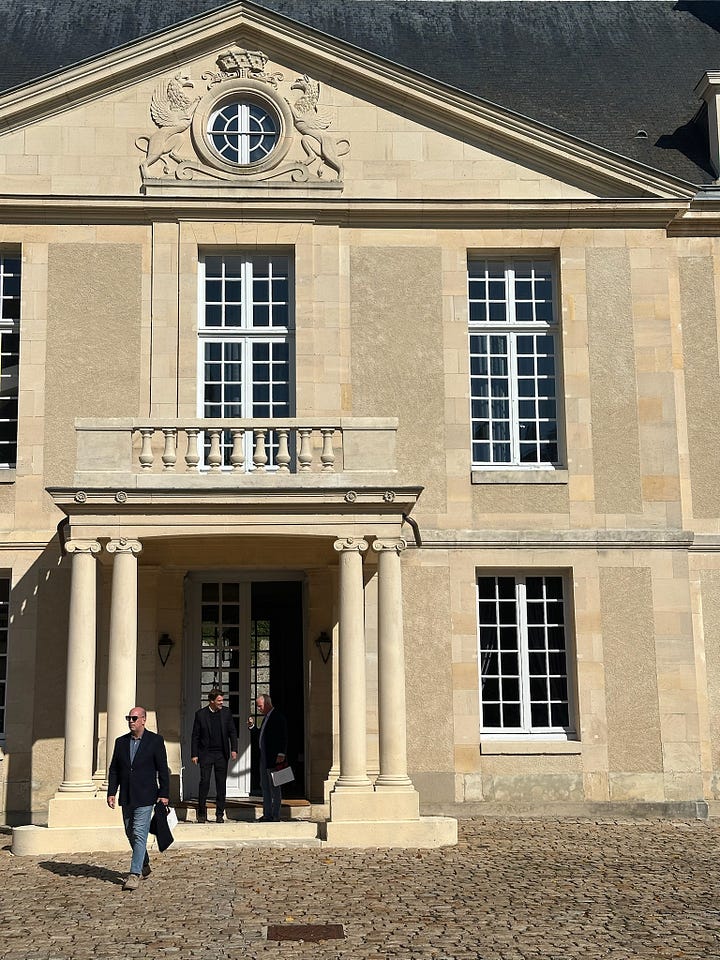
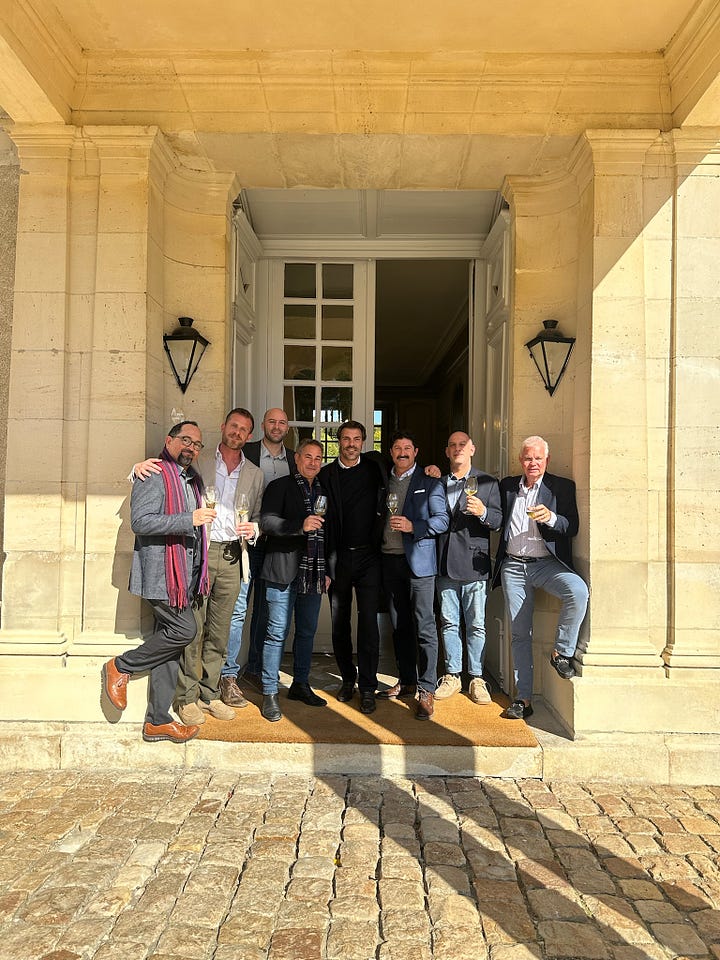
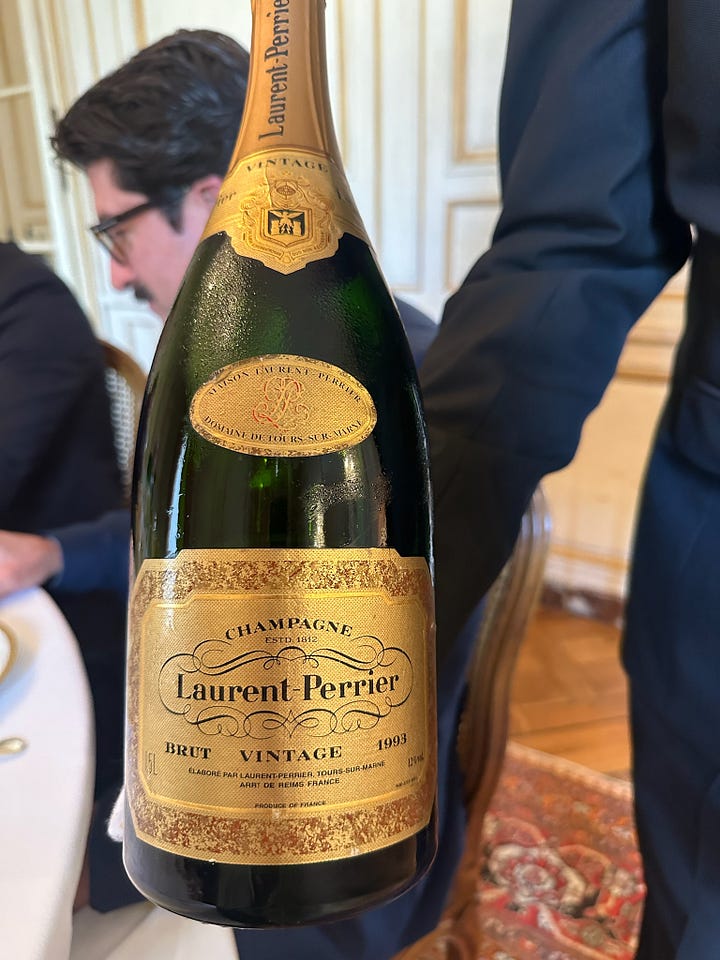
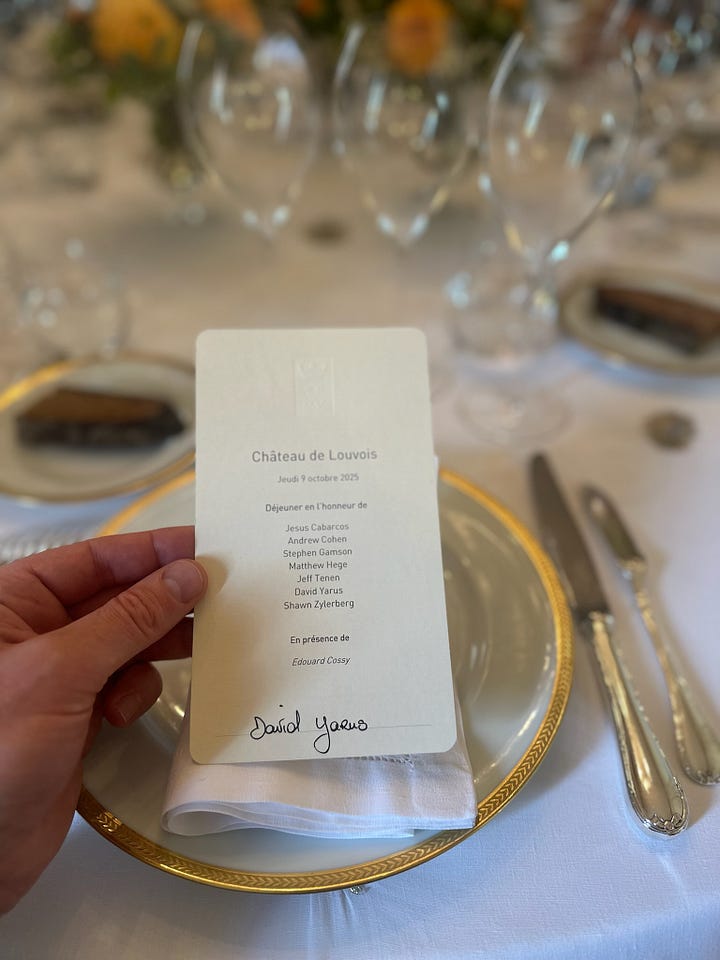
We talked about Edouard’s wine journey, how he manages one of the Great Houses of Champagne while balancing a big family led by four boys, our shared passion for the industry, and highlights of the trip so far. Davide and his assistant did a fantastic job, and we were led out into a clear afternoon with a beautiful breeze. I don’t know if it was the Champagne, but the colors amplified around us, the leaves wiggled in the air as they fell a long ways from where they detached, and life seemed so perfect at that moment.
Our next visit to Champagne Bérêche et Fils was polar opposite in wine style, going from House to Grower. Located in the town of Ludes, Champagne Bérêche et Fils was founded in 1847 and is run by the fifth generation with brothers Raphaël (winemaker) and Vincent (vineyard manager) Bérêche. Critics and wine geeks have come to admire this Champagne house deeply for its relentless focus on terroir expression over everything else. Their “house style” is the land they capture.
‘Grower’ Champagne is another word for estate-grown fruit, or a farmer’s Champagne. Most wineries buy their grapes from growers in Champagne. But Champagne Bérêche et Fils mostly uses their own grapes, a category that is growing in popularity. Raphaël led our tour of his small facility, where we ended up meeting his parents and brother as he walked us around. You could already tell this was a family business through and through. No amount of glass, cage or cork could contain Raphaël’s energy, measured in infinite bars of pressure. He uses the word ‘voila’ a lot which we loved, and he seemed like a mad scientist on a quest to capture the most accurate portrait of his land.
He stopped at a barrel, took out the rubber stopper and put his ear to the hole. He gestured us to dip our finger into the hole and hook out some brown, creamy yeast. We all tasted it and felt the sourness coat the palate. It was so raw, but we could already feel the glimpse of the finished product, that yeasty, bready, toasty flavor. He explained the 1911 strike in Champagne which exemplified his passion to protect the region and his family name. As we walked the barrel room and saw the bottles aging in cork (compared to the capsule at Laurent-Perrier), we noticed the winery was expanding with the newly excavated rooms. Raphaël’s laugh, incessant focus, and words are all the evidence we needed to know this expansion is well deserved.
“Sparkling wine is seven percent of global wine production,” he said. “But Champagne represents 58 percent of sparkling wine revenue.” This showed how important the region is and the legacy it carries.
Back upstairs, we all sat at a long table where Raphaël brought out his personal stemware for the Grand Cru tasting of his entire portfolio (Stephen’s favorite Champagne in the world):
Champagne Bérêche et Fils Brut Reserve. This is what makes up most of the volume in the portfolio. Sourced from 43 year old vines, this is 30/30/40 Chardonnay, Meunier and Pinot Noir blended across terroirs including Montagne de Reims. A very good portrait of the region.
Champagne Bérêche et Fils Aÿ Blanc Coteaux Champenois Grand Cru 2022. We have quickly become big fans of still white wine from Champagne, and this is why. If you love high acid wines, gravitate to this, if you can find it. Super light, electric fruit, and zippy structure.
Champagne Bérêche et Fils Rive Gauche 2021. This is where grower style is really starting to shine through. This is 100% Meunier from 55 year old vines, where baked apple, orchard fruit, smoked nutty aromas, and a post-rainshower feeling shines through.
Champagne Bérêche et Fils Reflet d’Antan Brut (20 year perpetual reserve). This was easily one of the favorites in the lineup. A stellar wine scooped from a 20-year reserve from 1985 to 2019! 30/30/40 Chardonnay, Meunier and Pinot Noir from 43 year old vines. Loads of lemon, salinity, and a lingering finish coat the palate in every corner. Wow wow wow!
Champagne Bérêche et Fils Cramant Grand Cru 2019. This 100% Chardonnay comes from 45 year old vines showcasing creamy lemon, pastry and brioche notes, and lots of lees character. The color is incredible.
Champagne Bérêche et Fils Ambonnay Grand Cru 2019. Another stunner. This wine 100% Pinot Noir from 45 year old vines, capturing a nice velvet touch and a top down x ray of a strawberry. Big fan of this gem.
Champagne Bérêche et Fils Mailly Champagne Grand Cru 2019. Another 100% Pinot Noir from slightly older 50 year old vines, this wine is more structured than the others, a macho man feel to it that keeps the columns of red orchard fruit strong, supporting a roof of complex baked spice flavors.
Champagne Bérêche et Fils Aÿ Ludes Prmier Cru 2017. Ok, this is next level. 75/25 Pinot Noir/Chardonnay from 50 year old vines that lend itself to an intense wine that is majestic in aromas with lots of fruit energy and powerful stone, chalk, and mineral sparks. Lovely.
Champagne Bérêche et Fils Une Champagne Millesime 2015. The last wine in the lineup is an homage to the family name, and the wine that felt least ready to enjoy. It needs more time. It is 50/50 Pinot Noir/Chardonnay with just 850 bottles made. It is a blend of Avize, Cramant, Ay, Ambonnay and Mailly. It felt a bit muted but all of us knew it would be a powerhouse Champagne to enjoy 10+ years, if you are lucky to find it.
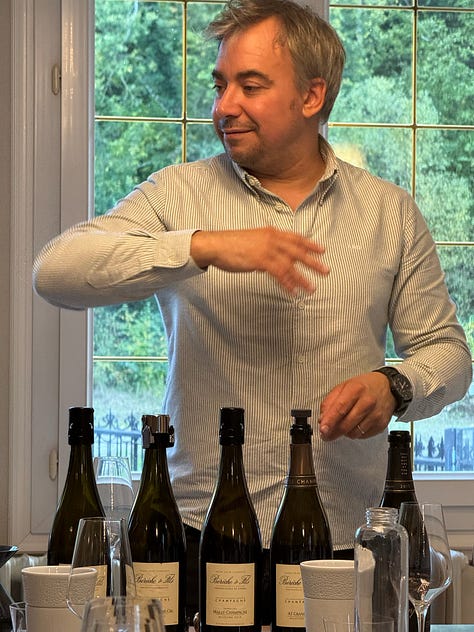
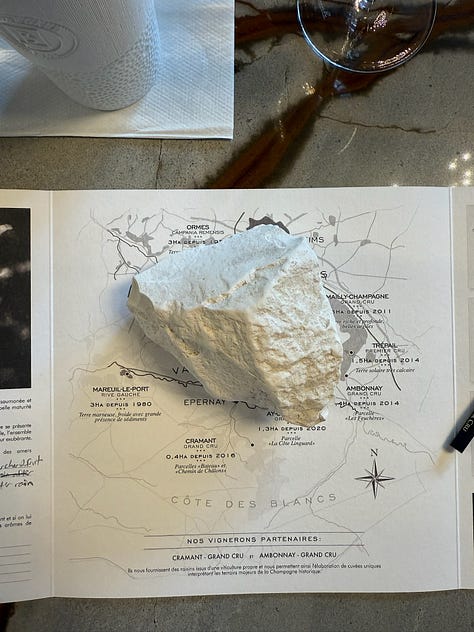
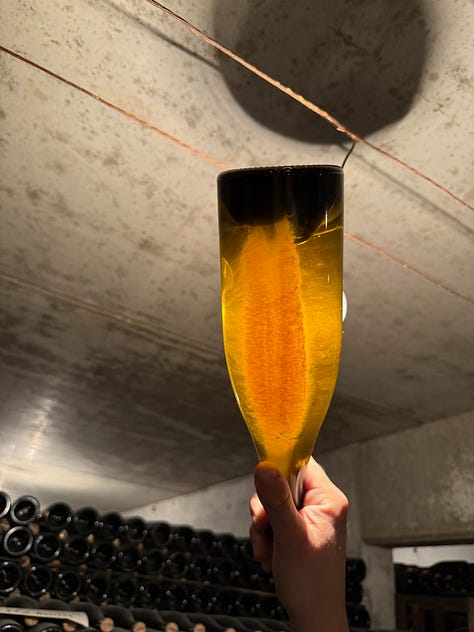
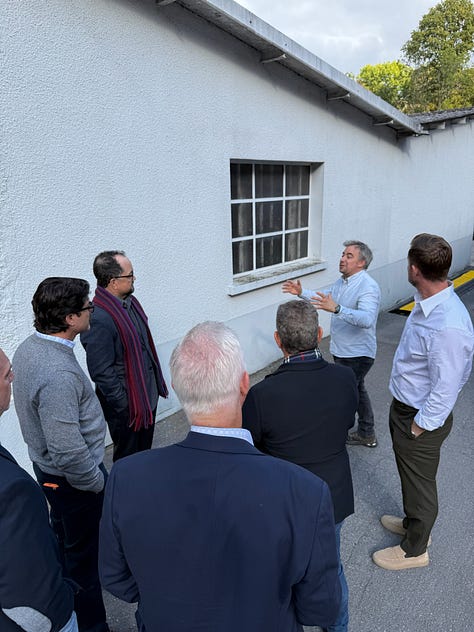
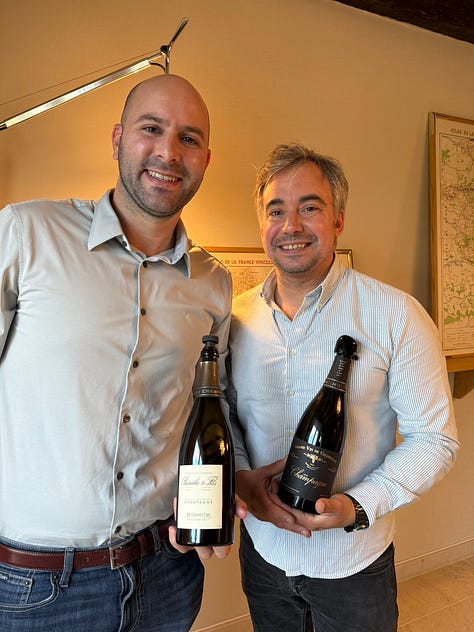
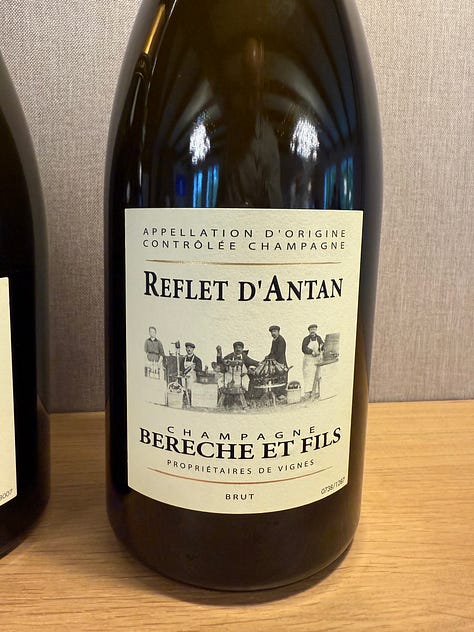
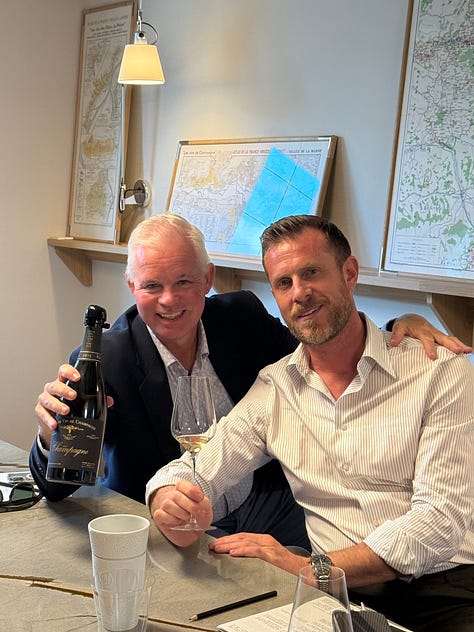
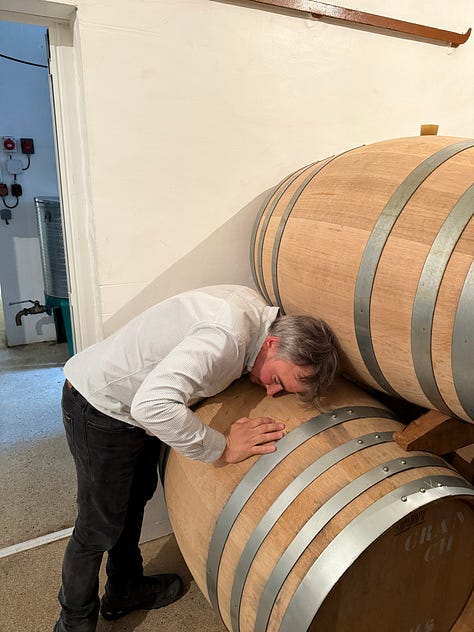
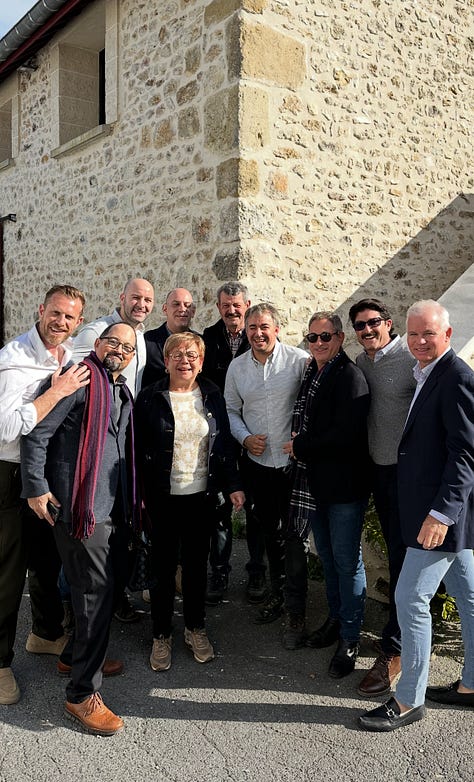
We got there not being too familiar with Bérêche, and left huge fans hoping to open bottles in Miami sooner rather than later. Stephen is in!
We ended the day gathering for a great burger at Sacre Burger in the heart of Reims. Like all the places we went to, the list was unbelievable. Jeff had been salivating to taste Clos Rougeard at some point, so we started with Champagne George Laval Garennes Extra Brut, a very good bottle to wake us back up, and dived into the meats with Clos Rougeard Saumur Champigny 2019, a dark, brooding Cabernet Franc that smelled and tasted older than it was. An old soul as we say. It did not disappoint.
Following dinner, Jesus gave us a night tour of the city (he’s a regular in Reims), where we passed the magnificent city hall and marveled at all the local nightlife happening around us. Whatever the headlines say about alcohol consumption, it’s strong as hell in Europe. Every night it seems the young and old gather to drink, smoke, and converse as if time didn’t exist. It’s important to stay sane. Vital actually.
Day Five - October 10
Just like M. Chapoutier and Delas on our first day, the two Champagne houses we visited today were a short walk from our stays: Champagne Louis Roederer and Champagne Taittinger. Our 10am appointment turned to 10:15am when we realized we were at the wrong entrance only 100 feet away. You can do a lot of damage in 15 minutes at a tasting, so we sped up like Stephen at an all you can eat Bérêche Buffet.
Our guide at Louis Roederer was Sarah, extremely well-versed in the history of the icon estate behind one of the most revered Champagnes in the world: Cristal. Champagne Louis Roederer was founded in 1776 and is one of the few remaining independent family-owned Champagne houses of large scale. Behind Taittinger and Moet & Chandon, Louis Roederer is the biggest landowner with 240 hectares under the name. Jean-Baptiste Lécaillon is the famous Chef de Cave (Cellar Master) since 1999 of the House and in charge of producing exceptional wines year over year, a consistency that makes him one of the best in the world.
We didn’t meet JBL, but were lucky to brush shoulders with Frédéric Rouzaud, seventh generation owner, in the hallways. We started the tour with a well crafted digital presentation of the House and its different plots across the regions, which did an amazing job of showing the depth of the terroir that makes this place so unique and unreplicable.
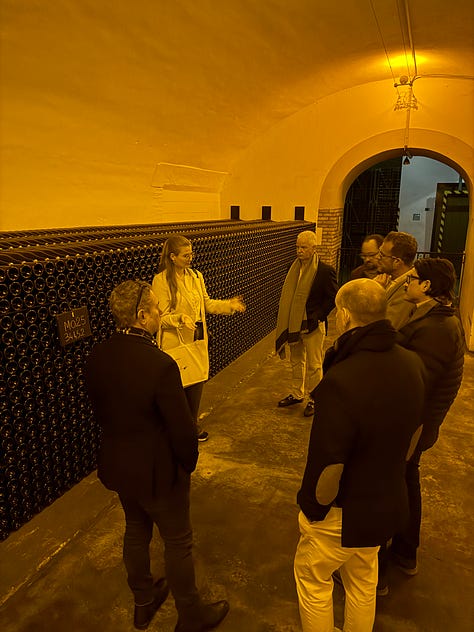
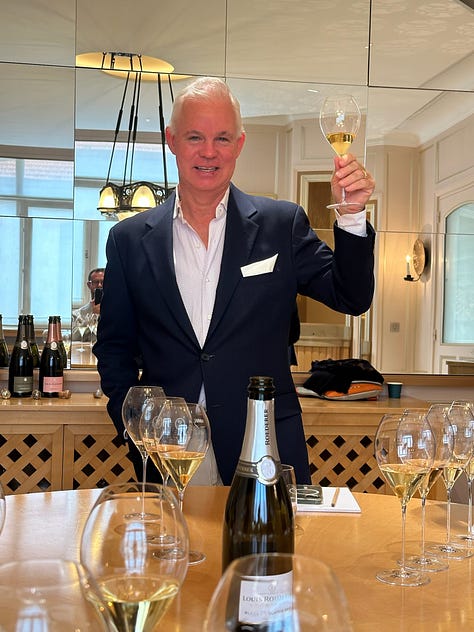
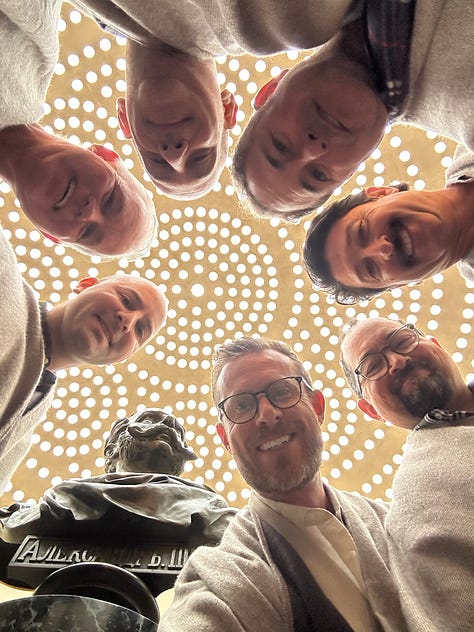
A spiral staircase took us to the deepest point of the cellars, where magnums and double magnums of clear bottles destined for Cristal were being riddled. The walls were wet and muggy from the humidity (a good sign). The story of Cristal starts in 1876, when the family commissioned the wine for Tsar Alexander II of Russia. The name “Cristal” comes from the clear, flat-bottomed, leaded crystal bottle originally made for the Tsar. Unlike most bottles, it has a flat bottom. The flat bottom allowed the Cossack guards to check for explosives in the bottle, and it remained that way. The grapes are sourced from Roederer’s finest estate vineyards, particularly from Montagne de Reims, Vallée de la Marne, and Côte des Blancs. The vineyards are also biodynamic.
This year, we tasted the Cristal Rosé 2013 which competed for top Champagne of the tasting. It is a wine that, when made in exceptional years, exemplifies the magic of Champagne. Unfortunately, we did not taste Cristal this time around, but enjoyed a very solid lineup thanks to Sarah and the House’s generosity:
Champagne Louis Roederer Collection 246. This wine has a 2021 base, topped off with reserve wines from 2012 to 2017. Collection is one of the best bang for buck Champagnes out there and a favorite among many novices and experts alike. A well built, fruit forward version.
Champagne Louis Roederer Vintage 2016. As Sarah puts it, this 2016 vintage “catches the sun” with its vibrancy. It has 68% Pinot Noir from north facing slopes that create thicker skins, hence the tighter, tannic, fruit skin feel to it. It is rich, full bodied and creamy like the rest.
Champagne Louis Roederer Rosé 2017. This wine is 60/40 Pinot Noir/Chardonnay filled with blood orange hints and a subtle spiciness that makes it a very versatile pairing with any dish. You name it, WCM approves!
Champagne Louis Roederer Blanc de Blancs 2017. This last wine is a stunning 100% Chardonnay from Avize. There is no malolactic fermentation here, so the wine retains its high acidity and bone structure balanced by a pure, lean citrus profile. This was the private cuvee of the family that was made available in the 80s. Not even fit for the Tsar himself perhaps?
After some more good shots directed by Stephen and David, we headed off to lunch in two separate Ubers. Matt got to Brasserie Le Jardin first and ordered his favorite cocktail, the French 75, while one of our Ubers got lost and pretty much gave us a tour of Reims. We all ordered the prix fixe menu along with an electric Coche Dury Aligote 2017 and a sub 100 euro Château Thivin Côte de Brouilly Godefroy 2022, which showed how beautiful Cru Beaujolais can be at any time of the day with its carbonic grenade of ripe red fruit. Sure, we recapped the tastings but also talked about all things life, getting closer with every laugh that brought tears to our eyes.
We then walked off the big lunch and headed to Taittinger, one of the more touristy visits of the trip but a ‘can’t miss’ because of the famous 4th century chalk caves that go down 65 feet below street level. Two restaurateurs from Rotterdam joined our tour, and we instantly became one group sharing cultural exchanges. Putting wine aside, the caves of Taittinger are simply unbelievable, and a construction marvel. Like the caves of Petra or the ancient Greeks, it’s crazy to see staircases, sketches on walls, and chip marks that go back nearly two thousand years. These cold corridors below ground were refuges during World Wars and crusades, and now home to 20 million+ bottles of wine. The cave walls are entirely made of chalk, and each room is shaped like a triangle, whose walls lead to a tiny square at the top where a beam of light pokes through. A common theme among all the cellars we’ve been is the stillness. Aging wine cannot vibrate and must remain unbothered by the common movements of everyday life. The sheer volume and attention to detail shows how Champagne can achieve quality at volume, which is very tough in an industry like wine. These tunnels go for miles under the city of Reims, creating a world of bubbles beneath the land.
We ended the tour of the caves with a private tasting of Taittinger’s magnum cuvees: Comtes de Champagne Rose 2012 and the Comtes de Champagne Blanc de Blancs 2012. Our most recent dip into Comtes was at last year’s annual event where we opened the 2006 Rose which showed well. Both Comtes were excellent and showcased the House style, but this time around we really felt the 8-9g residual sugar on the wines, so the consensus was to wait a bit longer to open something like this, letting the sugar integrate more with the fruit and acidity. The caves and history of this place is what really made our jaws drop.
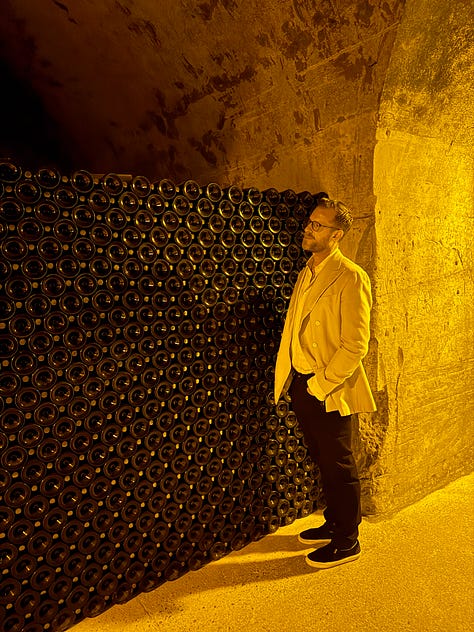
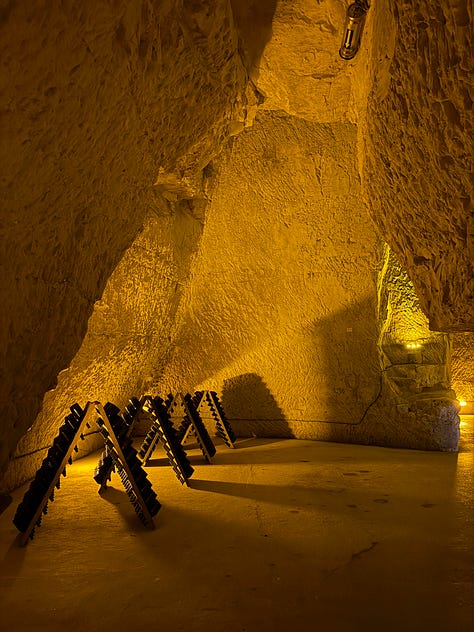
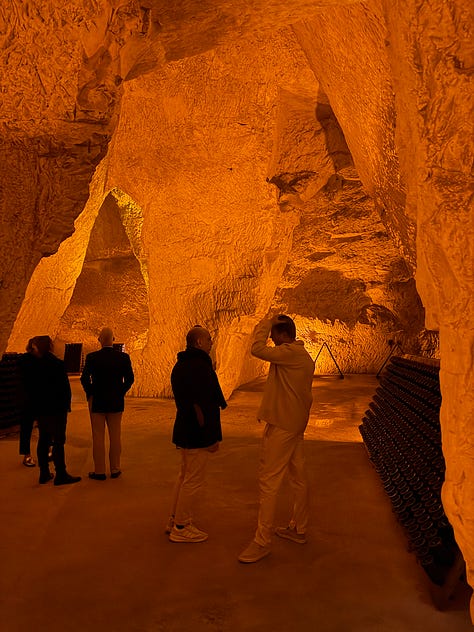
That night, we dined at a super cozy spot called L’Alambic, with a small underground cave lined by white coated bricks. Matt again ordered a French 75 but the lady who owned the restaurant had no idea what he was talking about. “I’ll show you how to make it,” Matt said. But instead he made it himself at the table. The lady just brought him an ounce of Cognac and glass of Champagne. Jeff and Jesus shared a red Burgundy that made us realize drinking great wine can ruin your appetite for house reds. But a drink is a drink.
Day Six - October 11
The day has come. The last supper…or lunch. We woke up with spirits higher than ever. Shining our armor, sharpening our swords, and fueling our systems with black espresso. Today had one name to it: Selosse. Our van departed at 11am for the small village of Avize, the HQ Domaine Jacques Selosse, headed by Anselme Selosse, who Jesus labels a ‘walking deity’ in Champagne. Anselme is the godfather of the grower champagne movement among many. The Domaine has a boutique hotel called Les Avises where you can taste his icon wines for a fair price. We booked the lunch there months in advance for noon sharp, right when they opened. Why? Because if you get there late, they might be out of their ‘eight’ rose allotments per day.
Jacques Selosse wines are very compelling for their unique, unapologetic style. That style revolves around oxidation. Anselme is heavily influenced by Spanish wines, especially those of Sherry. You can see that influence in the deep yellow color of the wines, but more in the aromas which remind us all of Sherry. People love it. And spend big bucks for it.
Today, some of Selosse’s wines go for $4,000+, and are desired by many in the world. Our host was the wife of the chef, a lovely lady with control over the room she deemed to serve with the same respect as Selosse gives his garden right behind the hotel. “This is the tasting,” Jeff reminded us. The culmination of this 20th anniversary trip we each worked hard to make happen. We ordered four bottles in total: Jacques Selosse Rosé (two bottles), Champagne Louis Roederer Coteaux Champenois Camille Hommage 2020, and the VO Jacques Selosse. The rosé was otherworldly, a film capture of wild strawberries and sweet spices. A wine one must try before they die. The VO (Version Originale) is a blend of older and younger wines, a complex and oxidative style that is an explosion of red apple, lemon curd, and wild sourdough flavors. The Coteaux Champenois from Louis Roederer is incredibly rare to find and was a fun pick for us since still whites from Champagne became a new discovery on this trip. The wine is an ‘hommage’ to Camille, the ingenious widow at the helm of Louis Roederer from 1932 to 1975 and quite possibly the reason we all know the name today. The wine is at the tipping point of austere but the wet stone, grapefruit and lemon on it, backed by high voltage acidity, make it irresistible. It needs one+ hour to open fully though.
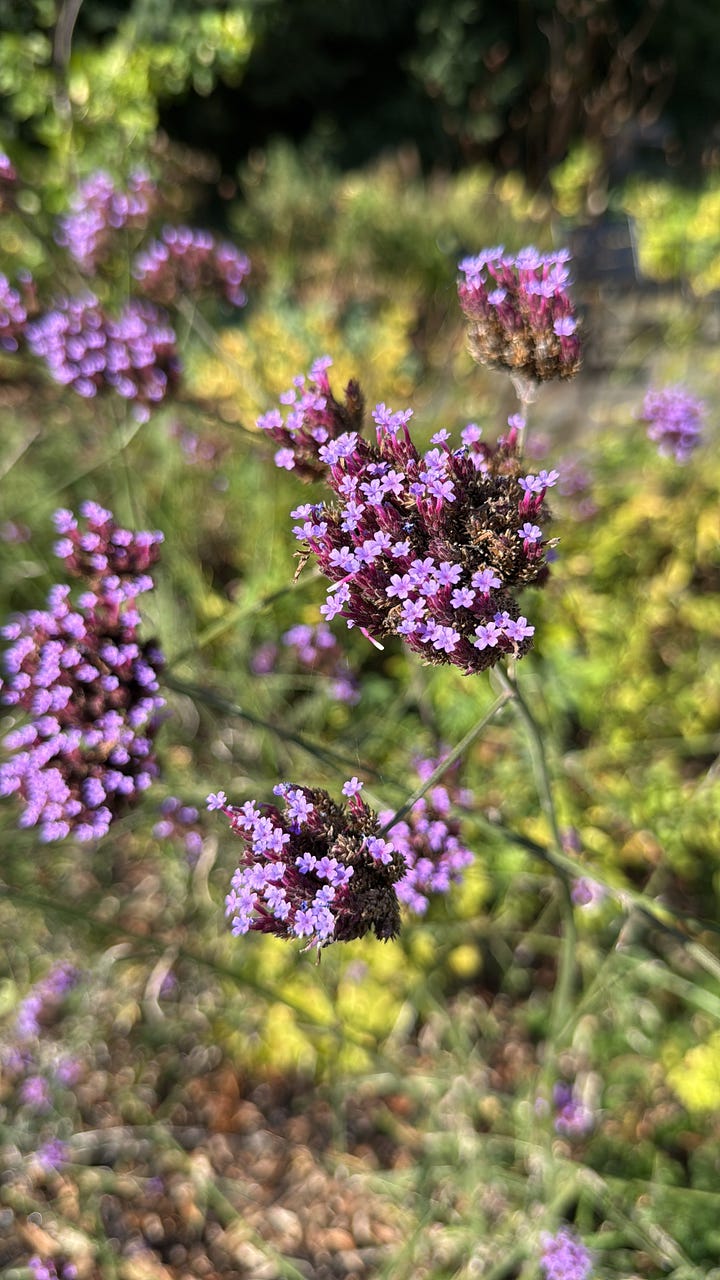
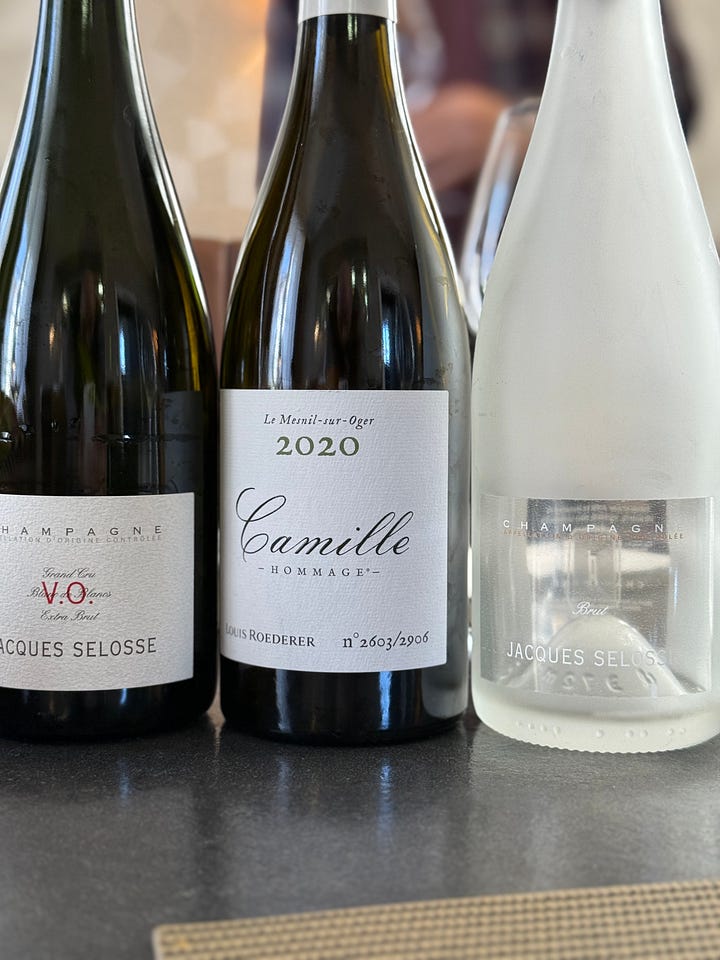
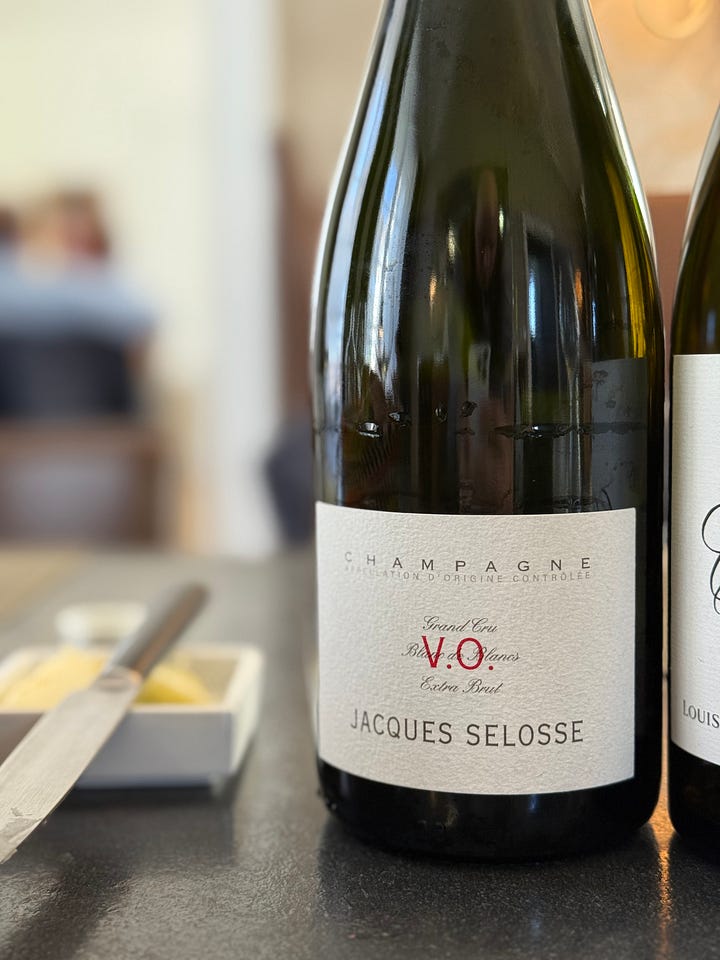
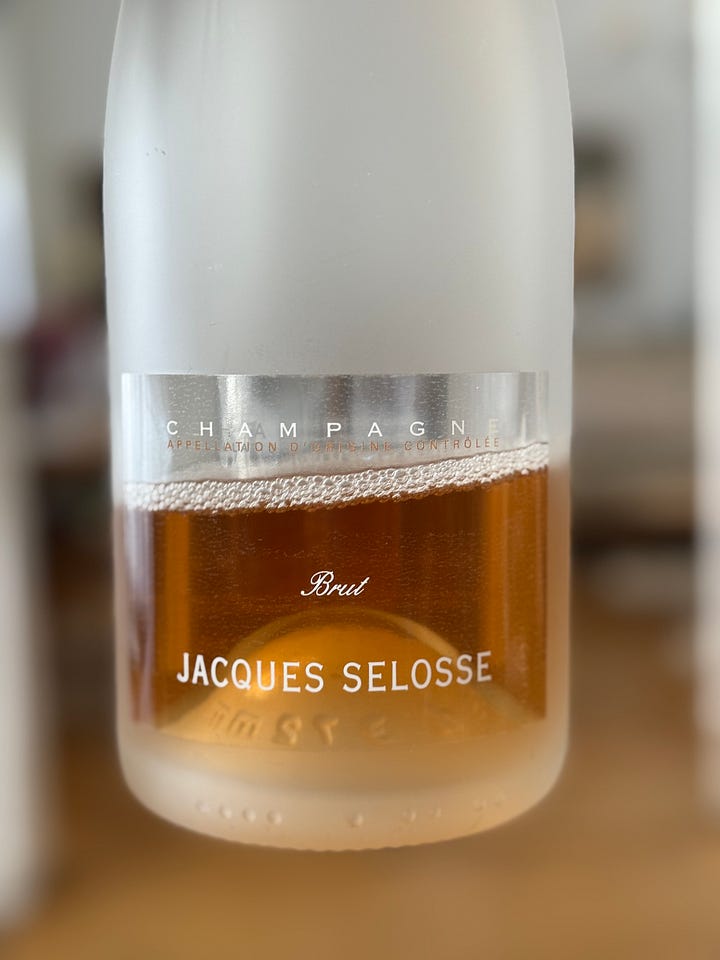
Right before dessert came out, David recommended we step out in the garden for a bit to take a breath of fresh air. All it took was weaving through the grass path with ingredients grown at our feet to understand the philosophy at Selosse, one rooted in the land and honoring that which is gives us: sustenance. Wine is the celebration of the very soil that gives us food, delight, and a reason to be with each other. We went back to the table (after some group pics of course), and enjoyed the last sips of nature that remained before floating out of Les Avizes on Selosse bubble balloons.
Once we returned to Reims, we went our separate ways before gathering back at the Airbnb for a light dinner. Some of us kept the wine going by stopping at Les Caves du Forum and trying some wines by the glass, including Auguste Clape’s Cornas 2022, an unbelievable red that captures the intense fruit, cool acidity, and powerful tannins of the Rhone. In the early evening, we put together a meat and cheese board while Jesus honored us with the last Champagne of the trip: Chartogne Taillet Les Couarres Parcelle de Merfy Extra Brut. For Andrew, it was Top 3 Champagnes of the trip, and for all of us, an epic taste to go out with a bang bang.
Day Seven - October 12
We departed the same way we came, separately and on our own time. Some of us continued the wine journey down to Chablis, others headed to Amsterdam, and some back home to Miami. It’s not easy to keep a group of guys together for a week, imagine 20 years. This anniversary is a testament to our founder Jeff Tenen’s vision for the club, which started when he got to Miami in the early 2000s. It is only now, after two decades, that Jeff feels the club is in a place he had imagined from the start. People have come and gone through these seats and strikes have put the group in jeopardy in the past, but what holds it all together is every single member’s commitment to be at every tasting, feeding our shared curiosity, and embracing the changing winds with open arms. We missed our eighth member, Wesley, on the trip, but his presence was felt at every visit and we hope he, along with everyone who reads this, can experience the ride of a lifetime.
Written by Shawn Zylberberg


